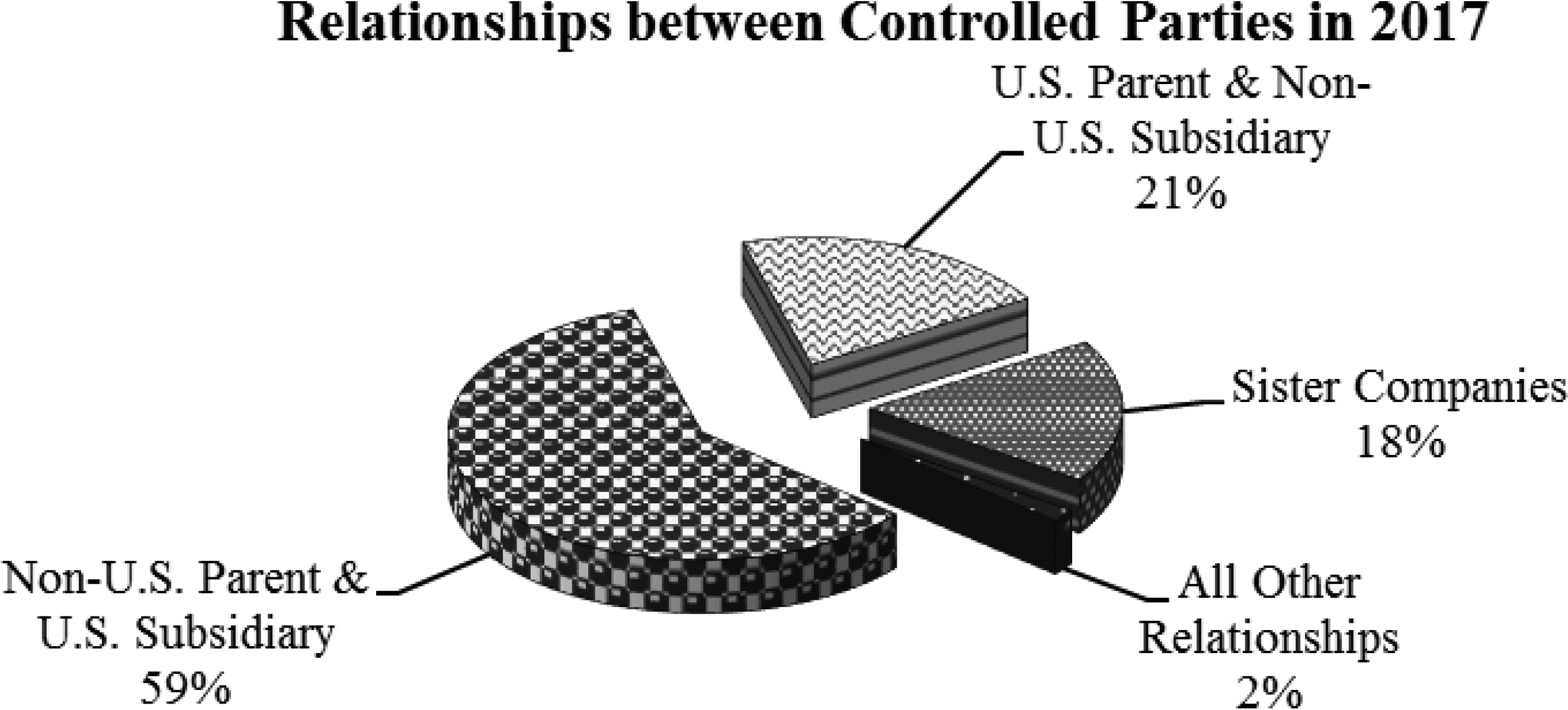Internal Revenue Bulletin: 2018-19
May 07, 2018
These synopses are intended only as aids to the reader in identifying the subject matter covered. They may not be relied upon as authoritative interpretations.
Announcement 2018–08 Announcement 2018–08
This Announcement is issued pursuant to § 521(b) of Pub. L. 106–170, the Ticket to Work and Work Incentives Improvement Act of 1999, which requires the Secretary of the Treasury to report annually to the public concerning advance pricing agreements (APAs) and the Advance Pricing and Mutual Agreement Program (APMA Program), formerly known as the Advance Pricing Agreement Program (APA Program). This nineteenth report describes the experience, structure, and activities of the APMA Program during calendar year 2017.
Notice 2018–34 Notice 2018–34
This notice sets forth updates on the corporate bond monthly yield curve, the corresponding spot segment rates for April 2018 used under § 417(e)(3)(D), the 24-month average segment rates applicable for April 2018, and the 30-year Treasury rates, as reflected by the application of § 430(h)(2)(C)(iv).
Provide America’s taxpayers top-quality service by helping them understand and meet their tax responsibilities and enforce the law with integrity and fairness to all.
The Internal Revenue Bulletin is the authoritative instrument of the Commissioner of Internal Revenue for announcing official rulings and procedures of the Internal Revenue Service and for publishing Treasury Decisions, Executive Orders, Tax Conventions, legislation, court decisions, and other items of general interest. It is published weekly.
It is the policy of the Service to publish in the Bulletin all substantive rulings necessary to promote a uniform application of the tax laws, including all rulings that supersede, revoke, modify, or amend any of those previously published in the Bulletin. All published rulings apply retroactively unless otherwise indicated. Procedures relating solely to matters of internal management are not published; however, statements of internal practices and procedures that affect the rights and duties of taxpayers are published.
Revenue rulings represent the conclusions of the Service on the application of the law to the pivotal facts stated in the revenue ruling. In those based on positions taken in rulings to taxpayers or technical advice to Service field offices, identifying details and information of a confidential nature are deleted to prevent unwarranted invasions of privacy and to comply with statutory requirements.
Rulings and procedures reported in the Bulletin do not have the force and effect of Treasury Department Regulations, but they may be used as precedents. Unpublished rulings will not be relied on, used, or cited as precedents by Service personnel in the disposition of other cases. In applying published rulings and procedures, the effect of subsequent legislation, regulations, court decisions, rulings, and procedures must be considered, and Service personnel and others concerned are cautioned against reaching the same conclusions in other cases unless the facts and circumstances are substantially the same.
The Bulletin is divided into four parts as follows:
Part I.—1986 Code. This part includes rulings and decisions based on provisions of the Internal Revenue Code of 1986.
Part II.—Treaties and Tax Legislation. This part is divided into two subparts as follows: Subpart A, Tax Conventions and Other Related Items, and Subpart B, Legislation and Related Committee Reports.
Part III.—Administrative, Procedural, and Miscellaneous. To the extent practicable, pertinent cross references to these subjects are contained in the other Parts and Subparts. Also included in this part are Bank Secrecy Act Administrative Rulings. Bank Secrecy Act Administrative Rulings are issued by the Department of the Treasury’s Office of the Assistant Secretary (Enforcement).
Part IV.—Items of General Interest. This part includes notices of proposed rulemakings, disbarment and suspension lists, and announcements.
The last Bulletin for each month includes a cumulative index for the matters published during the preceding months. These monthly indexes are cumulated on a semiannual basis, and are published in the last Bulletin of each semiannual period.
This notice provides guidance on the corporate bond monthly yield curve, the corresponding spot segment rates used under § 417(e)(3), and the 24-month average segment rates under § 430(h)(2) of the Internal Revenue Code. In addition, this notice provides guidance as to the interest rate on 30-year Treasury securities under § 417(e)(3)(A)(ii)(II) as in effect for plan years beginning before 2008 and the 30-year Treasury weighted average rate under § 431(c)(6)(E)(ii)(I).
Section 430 specifies the minimum funding requirements that apply to single-employer plans (except for CSEC plans under § 414(y)) pursuant to § 412. Section 430(h)(2) specifies the interest rates that must be used to determine a plan’s target normal cost and funding target. Under this provision, present value is generally determined using three 24-month average interest rates (“segment rates”), each of which applies to cash flows during specified periods. To the extent provided under § 430(h)(2)(C)(iv), these segment rates are adjusted by the applicable percentage of the 25-year average segment rates for the period ending September 30 of the year preceding the calendar year in which the plan year begins.[1] However, an election may be made under § 430(h)(2)(D)(ii) to use the monthly yield curve in place of the segment rates.
Notice 2007–81, 2007–44 I.R.B. 899, provides guidelines for determining the monthly corporate bond yield curve, and the 24-month average corporate bond segment rates used to compute the target normal cost and the funding target. Consistent with the methodology specified in Notice 2007–81, the monthly corporate bond yield curve derived from March 2018 data is in Table 2018–3 at the end of this notice. The spot first, second, and third segment rates for the month of March 2018 are, respectively, 2.91, 3.99, and 4.43.
The 24-month average segment rates determined under § 430(h)(2)(C)(i) through (iii) must be adjusted pursuant to § 430(h)(2)(C)(iv) to be within the applicable minimum and maximum percentages of the corresponding 25-year average segment rates. For plan years beginning before 2021, the applicable minimum percentage is 90% and the applicable maximum percentage is 110%. The 25-year average segment rates for plan years beginning in 2016, 2017, and 2018 were published in Notice 2015–61, 2015–39 I.R.B. 408, Notice 2016–54, 2016–40 I.R.B. 429, and Notice 2017–50, 2017–41 I.R.B. 280, respectively.
The three 24-month average corporate bond segment rates applicable for April 2018 without adjustment for the 25-year average segment rate limits are as follows:
| 24-Month Average Segment Rates Without 25-Year Average Adjustment | |||
|---|---|---|---|
| Applicable Month | First Segment | Second Segment | Third Segment |
| April 2018 | 1.94 | 3.66 | 4.44 |
Based on § 430(h)(2)(C)(iv), the 24-month averages applicable for April 2018, adjusted to be within the applicable minimum and maximum percentages of the corresponding 25-year average segment rates, are as follows:
| Adjusted 24-Month Average Segment Rates | ||||
|---|---|---|---|---|
| For Plan Years Beginning In | Applicable Month | First Segment | Second Segment | Third Segment |
| 2017 | April 2018 | 4.16 | 5.72 | 6.48 |
| 2018 | April 2018 | 3.92 | 5.52 | 6.29 |
Section 431 specifies the minimum funding requirements that apply to multiemployer plans pursuant to § 412. Section 431(c)(6)(B) specifies a minimum amount for the full-funding limitation described in § 431(c)(6)(A), based on the plan’s current liability. Section 431(c)(6)(E)(ii)(I) provides that the interest rate used to calculate current liability for this purpose must be no more than 5 percent above and no more than 10 percent below the weighted average of the rates of interest on 30-year Treasury securities during the four-year period ending on the last day before the beginning of the plan year. Notice 88–73, 1988–2 C.B. 383, provides guidelines for determining the weighted average interest rate. The rate of interest on 30-year Treasury securities for March 2018 is 3.09 percent. The Service determined this rate as the average of the daily determinations of yield on the 30-year Treasury bond maturing in February 2048. For plan years beginning in April 2018, the weighted average of the rates of interest on 30-year Treasury securities and the permissible range of rates used to calculate current liability are as follows:
| Treasury Weighted Average Rates | |||
|---|---|---|---|
| For Plan Years | 30-Year Treasury | Permissible Range | |
| Beginning In | Weighted Average | 90% to 105% | |
| April 2018 | 2.84 | 2.56 to 2.98 | |
In general, the applicable interest rates under § 417(e)(3)(D) are segment rates computed without regard to a 24-month average. Notice 2007–81 provides guidelines for determining the minimum present value segment rates. Pursuant to that notice, the minimum present value segment rates determined for March 2018 are as follows:
| Minimum Present Value Segment Rates | |||
|---|---|---|---|
| Month | First Segment | Second Segment | Third Segment |
| March 2018 | 2.91 | 3.99 | 4.43 |
The principal author of this notice is Tom Morgan of the Office of the Associate Chief Counsel (Tax Exempt and Government Entities). However, other personnel from the IRS participated in the development of this guidance. For further information regarding this notice, contact Mr. Morgan at 202-317-6700 or Tony Montanaro at 202-317-8698 (not toll-free numbers).
| Table 2018–3 | |||||||||
|---|---|---|---|---|---|---|---|---|---|
| Monthly Yield Curve for March 2018 | |||||||||
| Derived from March 2018 Data | |||||||||
| Maturity | Yield | Maturity | Yield | Maturity | Yield | Maturity | Yield | Maturity | Yield |
| 0.5 | 2.37 | 20.5 | 4.29 | 40.5 | 4.44 | 60.5 | 4.49 | 80.5 | 4.52 |
| 1.0 | 2.53 | 21.0 | 4.30 | 41.0 | 4.44 | 61.0 | 4.50 | 81.0 | 4.52 |
| 1.5 | 2.68 | 21.5 | 4.31 | 41.5 | 4.45 | 61.5 | 4.50 | 81.5 | 4.52 |
| 2.0 | 2.81 | 22.0 | 4.31 | 42.0 | 4.45 | 62.0 | 4.50 | 82.0 | 4.52 |
| 2.5 | 2.92 | 22.5 | 4.32 | 42.5 | 4.45 | 62.5 | 4.50 | 82.5 | 4.52 |
| 3.0 | 3.01 | 23.0 | 4.32 | 43.0 | 4.45 | 63.0 | 4.50 | 83.0 | 4.52 |
| 3.5 | 3.10 | 23.5 | 4.33 | 43.5 | 4.45 | 63.5 | 4.50 | 83.5 | 4.52 |
| 4.0 | 3.17 | 24.0 | 4.33 | 44.0 | 4.45 | 64.0 | 4.50 | 84.0 | 4.52 |
| 4.5 | 3.24 | 24.5 | 4.34 | 44.5 | 4.46 | 64.5 | 4.50 | 84.5 | 4.52 |
| 5.0 | 3.31 | 25.0 | 4.34 | 45.0 | 4.46 | 65.0 | 4.50 | 85.0 | 4.52 |
| 5.5 | 3.38 | 25.5 | 4.35 | 45.5 | 4.46 | 65.5 | 4.50 | 85.5 | 4.53 |
| 6.0 | 3.45 | 26.0 | 4.35 | 46.0 | 4.46 | 66.0 | 4.50 | 86.0 | 4.53 |
| 6.5 | 3.51 | 26.5 | 4.36 | 46.5 | 4.46 | 66.5 | 4.50 | 86.5 | 4.53 |
| 7.0 | 3.57 | 27.0 | 4.36 | 47.0 | 4.46 | 67.0 | 4.50 | 87.0 | 4.53 |
| 7.5 | 3.63 | 27.5 | 4.37 | 47.5 | 4.47 | 67.5 | 4.51 | 87.5 | 4.53 |
| 8.0 | 3.69 | 28.0 | 4.37 | 48.0 | 4.47 | 68.0 | 4.51 | 88.0 | 4.53 |
| 8.5 | 3.75 | 28.5 | 4.38 | 48.5 | 4.47 | 68.5 | 4.51 | 88.5 | 4.53 |
| 9.0 | 3.80 | 29.0 | 4.38 | 49.0 | 4.47 | 69.0 | 4.51 | 89.0 | 4.53 |
| 9.5 | 3.84 | 29.5 | 4.38 | 49.5 | 4.47 | 69.5 | 4.51 | 89.5 | 4.53 |
| 10.0 | 3.89 | 30.0 | 4.39 | 50.0 | 4.47 | 70.0 | 4.51 | 90.0 | 4.53 |
| 10.5 | 3.93 | 30.5 | 4.39 | 50.5 | 4.47 | 70.5 | 4.51 | 90.5 | 4.53 |
| 11.0 | 3.97 | 31.0 | 4.39 | 51.0 | 4.47 | 71.0 | 4.51 | 91.0 | 4.53 |
| 11.5 | 4.00 | 31.5 | 4.40 | 51.5 | 4.48 | 71.5 | 4.51 | 91.5 | 4.53 |
| 12.0 | 4.03 | 32.0 | 4.40 | 52.0 | 4.48 | 72.0 | 4.51 | 92.0 | 4.53 |
| 12.5 | 4.06 | 32.5 | 4.40 | 52.5 | 4.48 | 72.5 | 4.51 | 92.5 | 4.53 |
| 13.0 | 4.09 | 33.0 | 4.41 | 53.0 | 4.48 | 73.0 | 4.51 | 93.0 | 4.53 |
| 13.5 | 4.11 | 33.5 | 4.41 | 53.5 | 4.48 | 73.5 | 4.51 | 93.5 | 4.53 |
| 14.0 | 4.14 | 34.0 | 4.41 | 54.0 | 4.48 | 74.0 | 4.51 | 94.0 | 4.53 |
| 14.5 | 4.15 | 34.5 | 4.41 | 54.5 | 4.48 | 74.5 | 4.51 | 94.5 | 4.53 |
| 15.0 | 4.17 | 35.0 | 4.42 | 55.0 | 4.48 | 75.0 | 4.51 | 95.0 | 4.53 |
| 15.5 | 4.19 | 35.5 | 4.42 | 55.5 | 4.48 | 75.5 | 4.52 | 95.5 | 4.53 |
| 16.0 | 4.20 | 36.0 | 4.42 | 56.0 | 4.49 | 76.0 | 4.52 | 96.0 | 4.53 |
| 16.5 | 4.22 | 36.5 | 4.42 | 56.5 | 4.49 | 76.5 | 4.52 | 96.5 | 4.53 |
| 17.0 | 4.23 | 37.0 | 4.43 | 57.0 | 4.49 | 77.0 | 4.52 | 97.0 | 4.53 |
| 17.5 | 4.24 | 37.5 | 4.43 | 57.5 | 4.49 | 77.5 | 4.52 | 97.5 | 4.53 |
| 18.0 | 4.25 | 38.0 | 4.43 | 58.0 | 4.49 | 78.0 | 4.52 | 98.0 | 4.53 |
| 18.5 | 4.26 | 38.5 | 4.43 | 58.5 | 4.49 | 78.5 | 4.52 | 98.5 | 4.54 |
| 19.0 | 4.27 | 39.0 | 4.44 | 59.0 | 4.49 | 79.0 | 4.52 | 99.0 | 4.54 |
| 19.5 | 4.28 | 39.5 | 4.44 | 59.5 | 4.49 | 79.5 | 4.52 | 99.5 | 4.54 |
| 20.0 | 4.29 | 40.0 | 4.44 | 60.0 | 4.49 | 80.0 | 4.52 | 100.0 | 4.54 |
[1] Pursuant to § 433(h)(3)(A), the 3rd segment rate determined under § 430(h)(2)(C) is used to determine the current liability of a CSEC plan (which is used to calculate the minimum amount of the full funding limitation under § 433(c)(7)(C)).
This Announcement is issued pursuant to § 521(b) of Pub. L. 106–170, the Ticket to Work and Work Incentives Improvement Act of 1999, which requires the Secretary of the Treasury to report annually to the public concerning advance pricing agreements (APAs) and the Advance Pricing and Mutual Agreement Program (APMA Program), formerly known as the Advance Pricing Agreement Program (APA Program). The first report covered calendar years 1991 through 1999. Subsequent reports covered each calendar year 2000 through 2016 separately. This nineteenth report describes the experience, structure, and activities of the APMA Program during calendar year 2017. It does not provide guidance regarding the application of the arm’s length standard.
Part I of this report includes information on the structure, composition, and operation of the APMA Program; Part II presents statistical data; and Part III includes general descriptions of various elements of the APAs executed in 2017, including types of transactions covered, transfer pricing methods used, and completion time.
John C.C. Hughes Director, Advance Pricing and Mutual Agreement Program[Pub. L. 106–170 § 521(b)(2)(A)]
In February 2012, the former APA Program was moved from the Office of Chief Counsel to the Office of Transfer Pricing Operations[2] within the Large Business and International Division of the IRS and combined with the U.S. Competent Authority staff responsible for transfer pricing cases, thereby forming the APMA Program.
As of December 29, 2017, the APMA Program included 55 team leaders, 17 economists, and 10 senior managers organized into 10 groups (7 team leader groups and 3 economist groups). The APMA Program’s main office is in Washington, DC, and it also has a significant presence in San Francisco and the Los Angeles area.
On August 31, 2015, new revenue procedures governing MAP and APA applications were published in 2015–35 I.R.B. on pages 236 and 263, respectively. Revenue Procedure (Rev. Proc.) 2015–41 provides guidance and instructions on filing APA requests as well as guidance and information on the administration of APAs. Rev. Proc. 2015–41 updates and supersedes Rev. Proc. 2006–9, 2006–1 C.B. 278, as modified by Rev. Proc. 2008–31, 2008–1 C.B. 1133, which is also superseded. Rev. Proc. 2015–40 provides procedures and guidance on requesting assistance from the U.S. Competent Authority where the taxpayer believes that the actions of the United States or a treaty country result or will result in the taxpayer being subject to taxation not in accordance with the applicable U.S. tax treaty. Rev. Proc. 2015–40 updates and supersedes Rev. Proc. 2006–54, 2006–2 C.B. 1035.
The 2009 model APA agreement appears in this report as Appendix 1. In the fall of 2017, APMA solicited comments on a proposed major revision. A list of primary APMA contacts is available at https://www.irs.gov/businesses/corporations/apma-contacts.
[Pub. L. 106–170 § 521(b)(2)(C)(i–viii)]
| Table 1: APA Applications Filed § 521(b)(2)(C)(i) | ||||
|---|---|---|---|---|
| Unilateral | Bilateral | Multilateral | Total | |
| Filed 1991–1999[a] | 401 | |||
| Filed 2000–2016 | 556 | 1278 | 10 | 1844 |
| Filed in 2017 | 14 | 86 | 1 | 101 |
| Total Filed 1991–2017 | 2346 | |||
|
[a] The first APA Statutory Report, which compiled APA data from 1991-1999, did not report the cumulative number of applications for those years by submission type, so the cumulative totals cannot be reported in that manner. |
||||
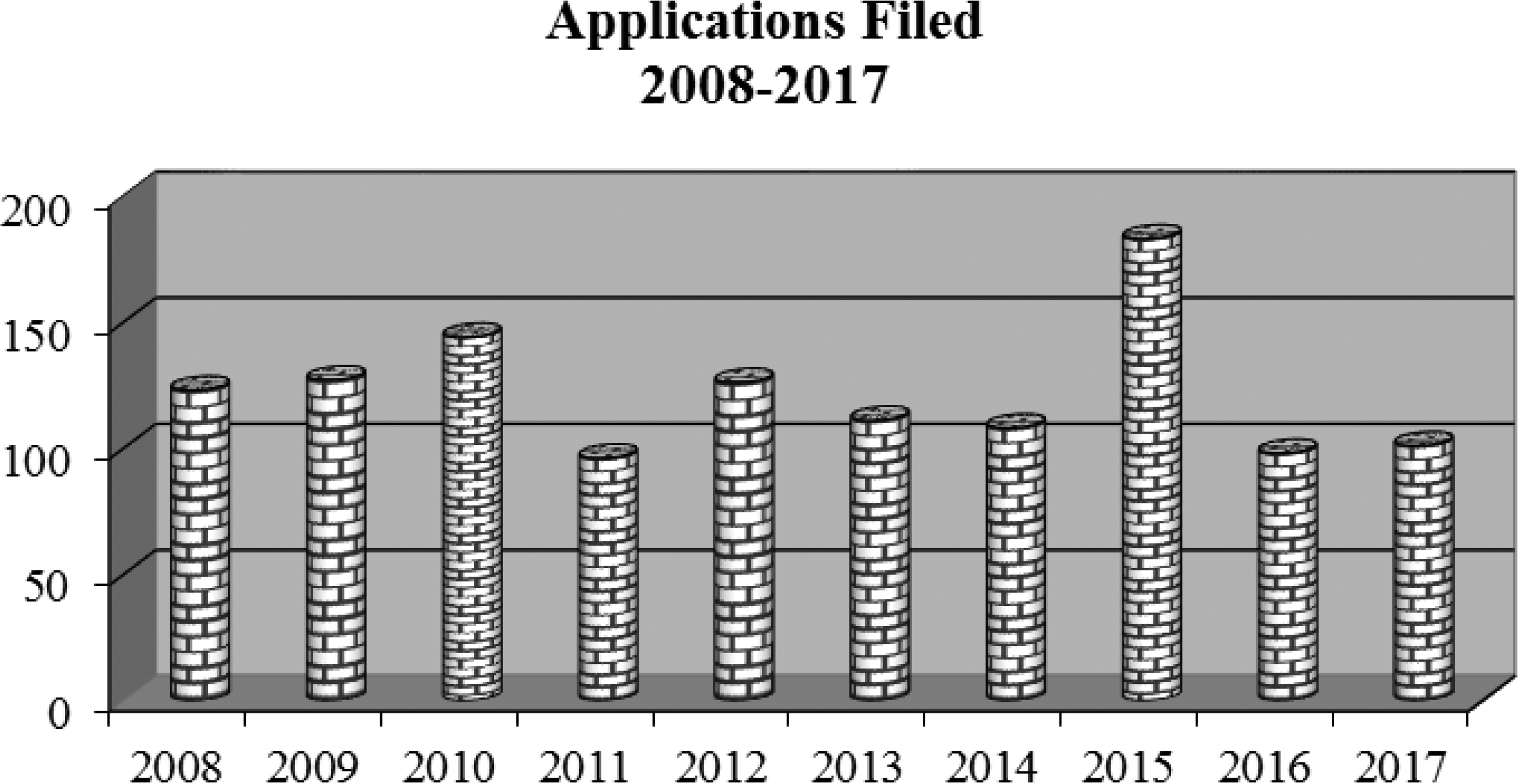
The table above illustrates the number of complete applications filed per year. As of December 31, 2017, APMA had also received 37 user fee filings that were not yet accompanied by substantially complete APA applications, in addition to the 101 complete APA applications.
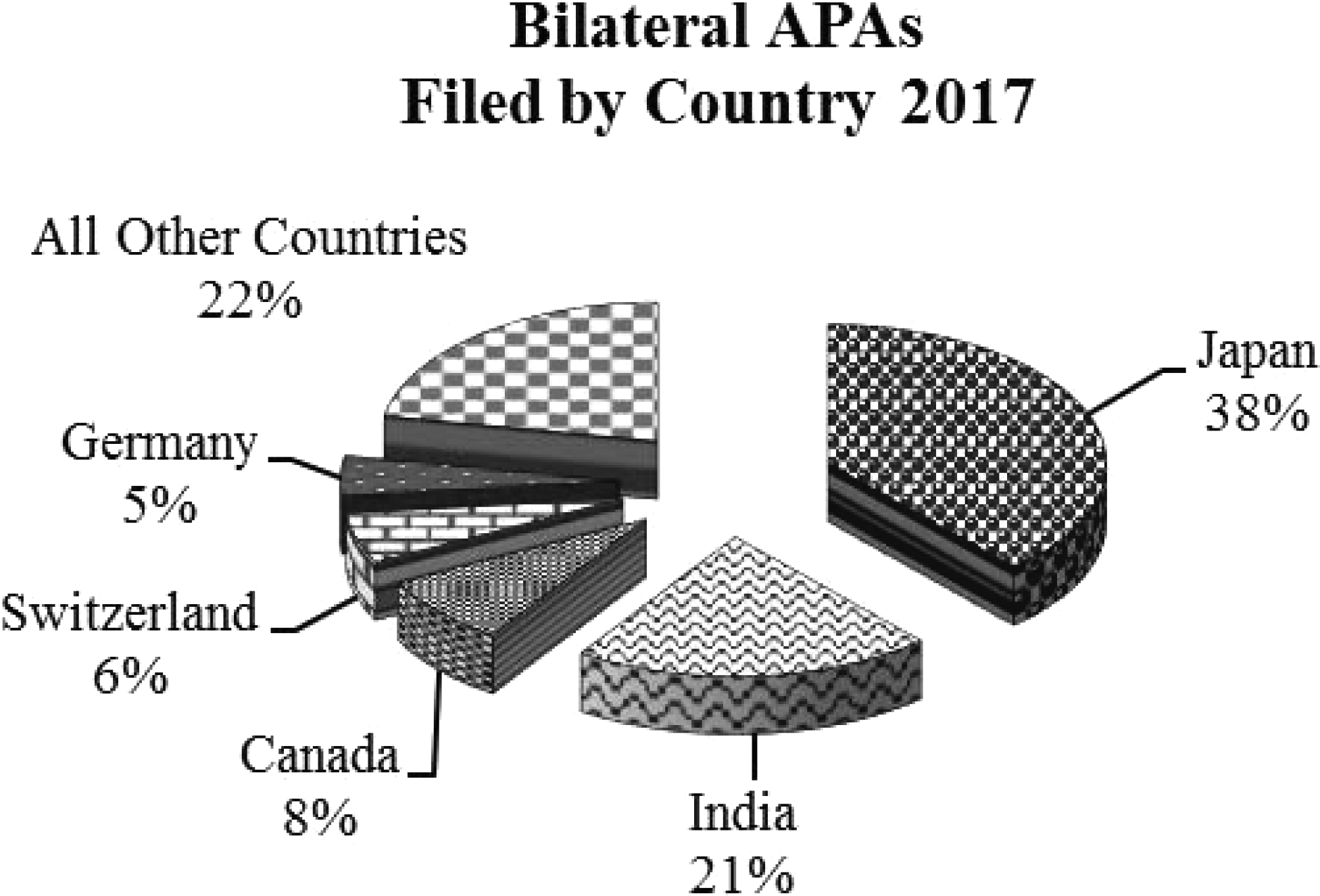
| Table 2: Executed and Pending APAs § 521(b)(2)(C)(ii–vi) | ||||
|---|---|---|---|---|
| Unilateral | Bilateral | Multilateral | Total | |
| Total Executed 1991–2016 | 560 | 1,023 | 14 | 1,597 |
| Total Executed in 2017 | 30 | 85 | 1 | 116 |
| Total Executed 1991–2017 | 590 | 1,108 | 15 | 1,713 |
| Total Pending as of 12/31/2017 | 57 | 321 | 8 | 386 |
| Renewals Executed in 2017 | 22 | 48 | 0 | 70 |
| Renewals Pending | 29 | 133 | 2 | 164 |
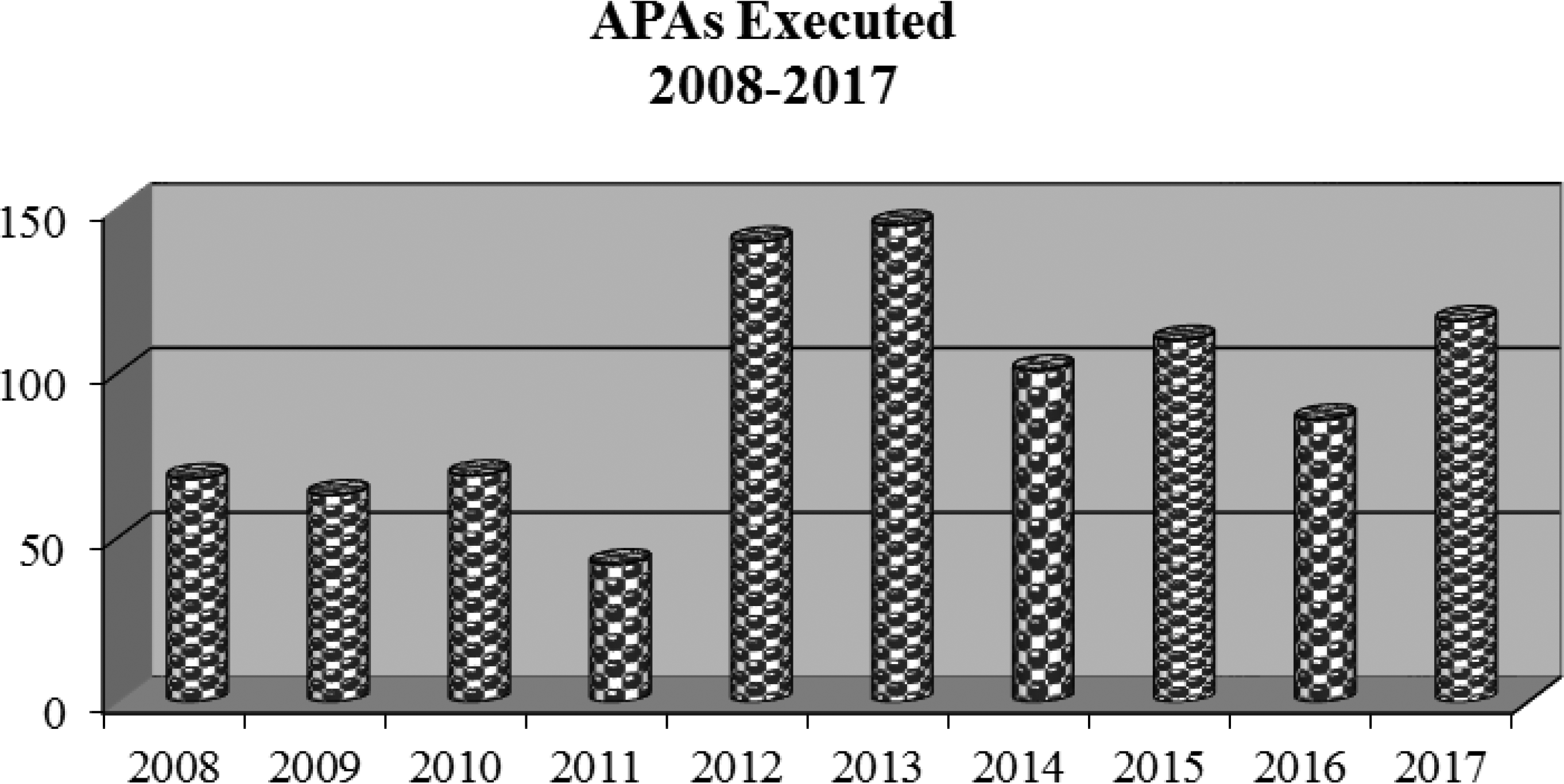
Of the 116 agreements executed in 2017, 40 percent were new APAs (i.e., not a renewal of a prior APA). This is consistent with prior years.

As the chart above illustrates, nearly three quarters of the total number of bilateral APAs executed in 2017 involved the United States entering into mutual agreements with either Japan or Canada.
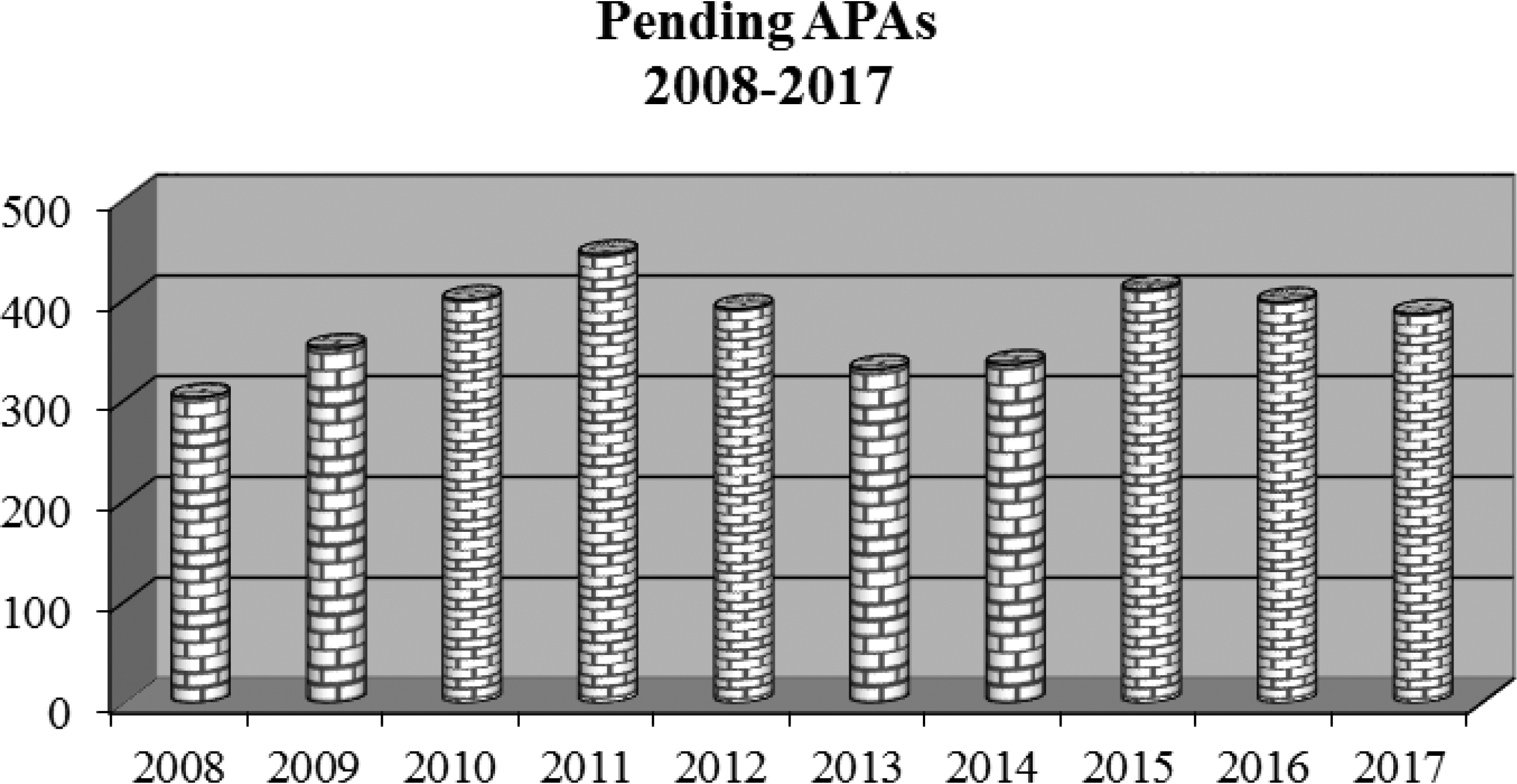
The number of pending APAs has continued to decline since 2015 with Japan, India, and Canada accounting for more than half of all pending bilateral APAs.
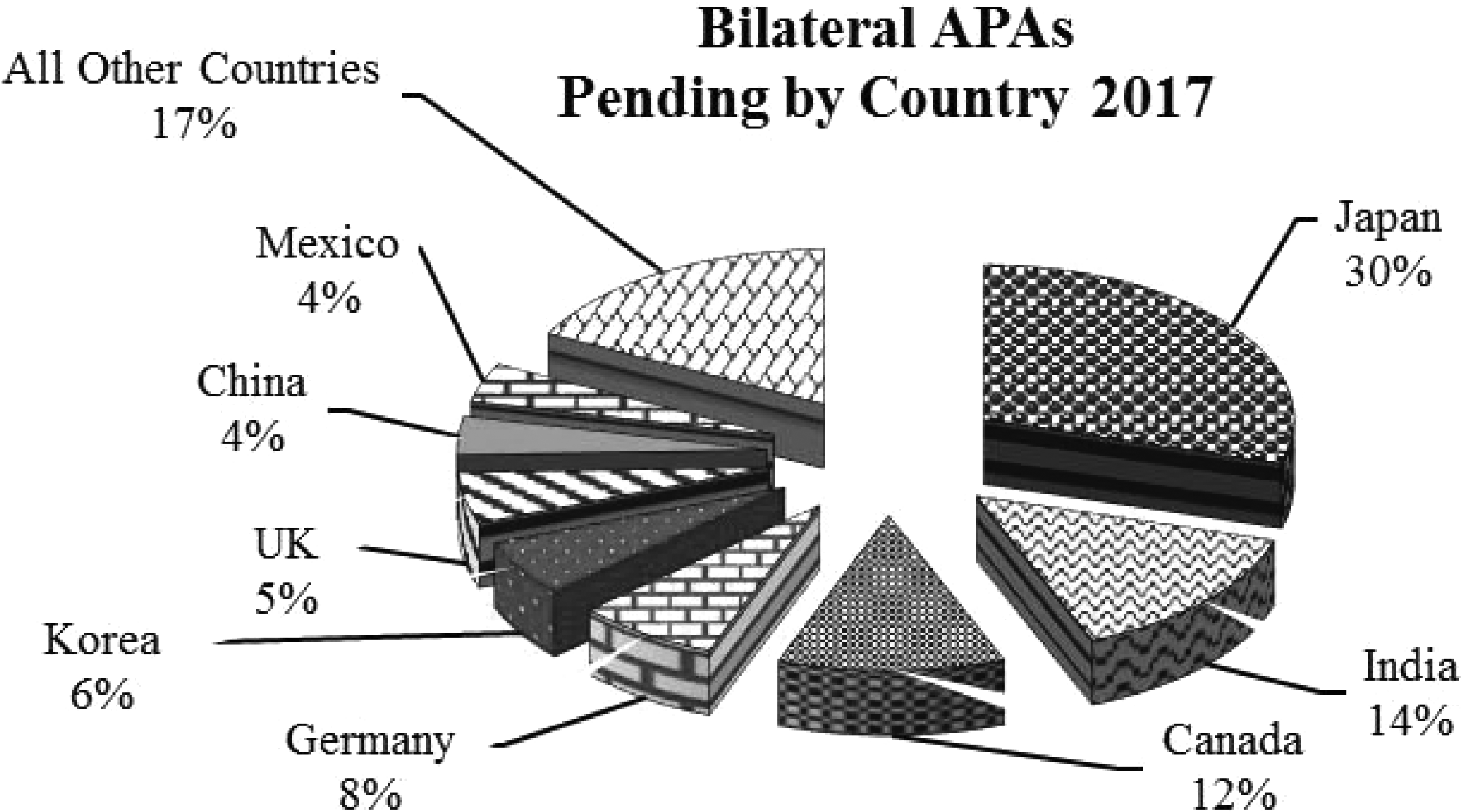
| Table 3: APAs Revoked or Cancelled and Applications Withdrawn § 521(b)(2)(C)(vii) | ||||
|---|---|---|---|---|
| Unilateral | Bilateral | Multilateral | Total | |
| Revoked or Cancelled in 2017 | 0 | 0 | 0 | 0 |
| Total Revoked or Cancelled 1991–2017[a] | 11 | |||
| Applications Withdrawn in 2017 | 1 | 6 | 1 | 8 |
| Total Applications Withdrawn 1991–2017 [b] | 232 | |||
|
[a] The first APA Statutory Report, which compiled APA data from 1991-1999, did not report the cumulative number of applications for those years by submission type, so the cumulative totals cannot be reported in that manner. [b] The first APA Statutory Report, which compiled APA data from 1991-1999, did not report the cumulative number of applications for those years by submission type, so the cumulative totals cannot be reported in that manner. |
||||
| Table 4: APAs Finalized or Renewed[a] by Industry § 521(b)(2)(C)(viii) | |
|---|---|
| Industry | |
| Manufacturing | 48 |
| Wholesale/Retail Trade | 43 |
| Services | 12 |
| Management | 6 |
| Finance, Insurance, and Real Estate | 4 |
| All Other Industries | 3 |
|
[a] APAs finalized or renewed are the same as APAs executed. |
|
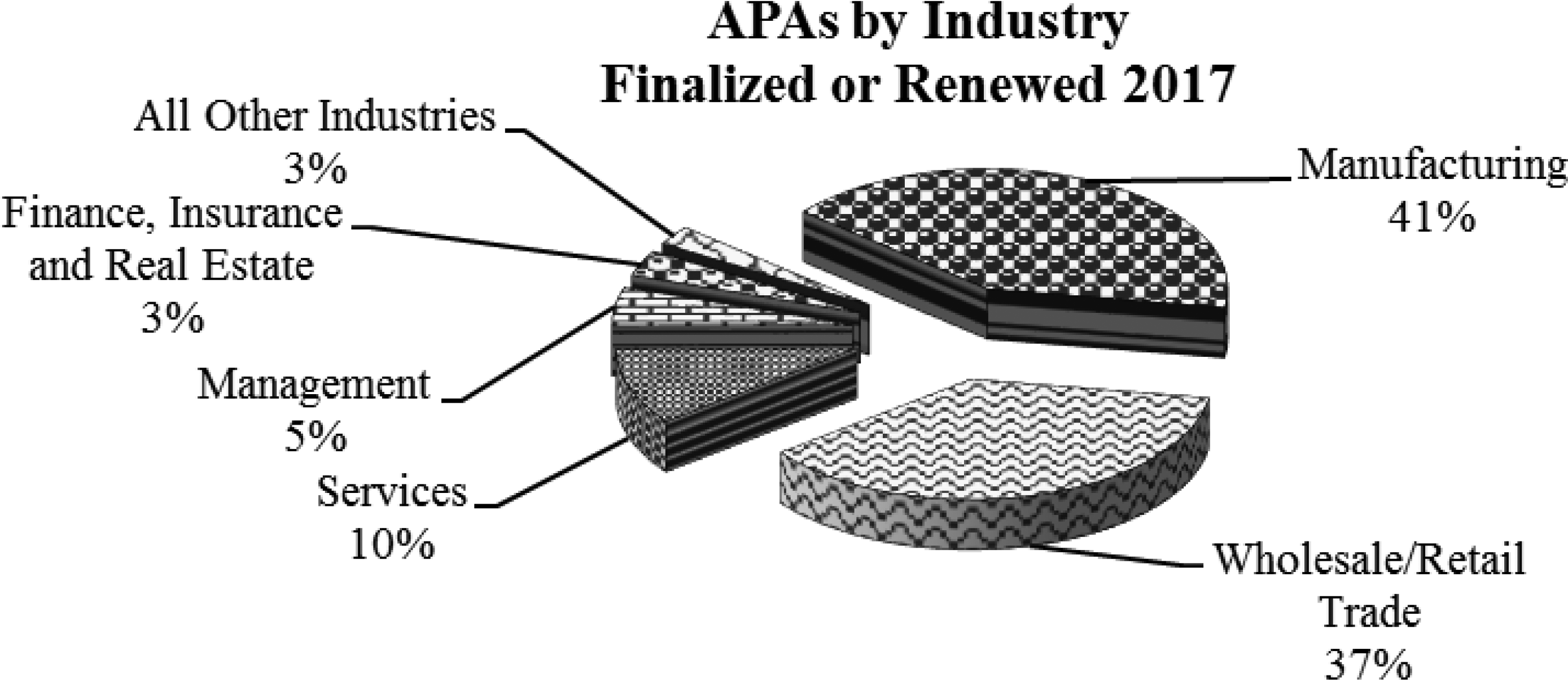
| Table 4a: Manufacturing APAs Finalized or Renewed 2017 | |
|---|---|
| Manufacturing | |
| Computer and Electronic Products | 9 |
| Chemical | 9 |
| Transportation Equipment | 8 |
| Miscellaneous Manufacturing[a] | 10 |
| All Other Types of Manufacturing | 12 |
|
[a] Miscellaneous Manufacturing is NAICS code 339. |
|
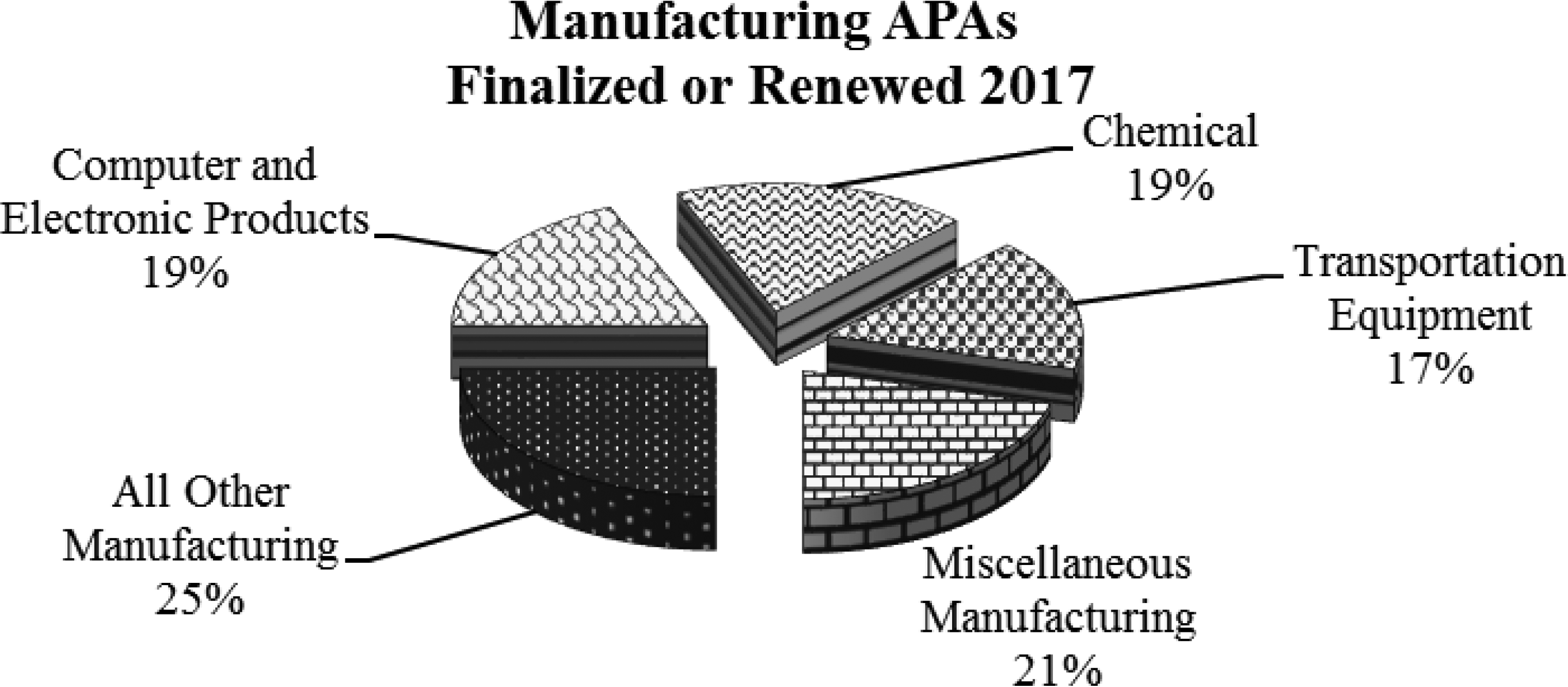
| Table 4b: Wholesale/Retail Trade APAs Finalized or Renewed 2017 | |
|---|---|
| Wholesale/Retail Trade | |
| Merchant Wholesalers, Durable Goods | 33 |
| Merchant Wholesalers, Nondurable Goods | 7 |
| All Other Types of Other Wholesale/Retail Trade | 3 |
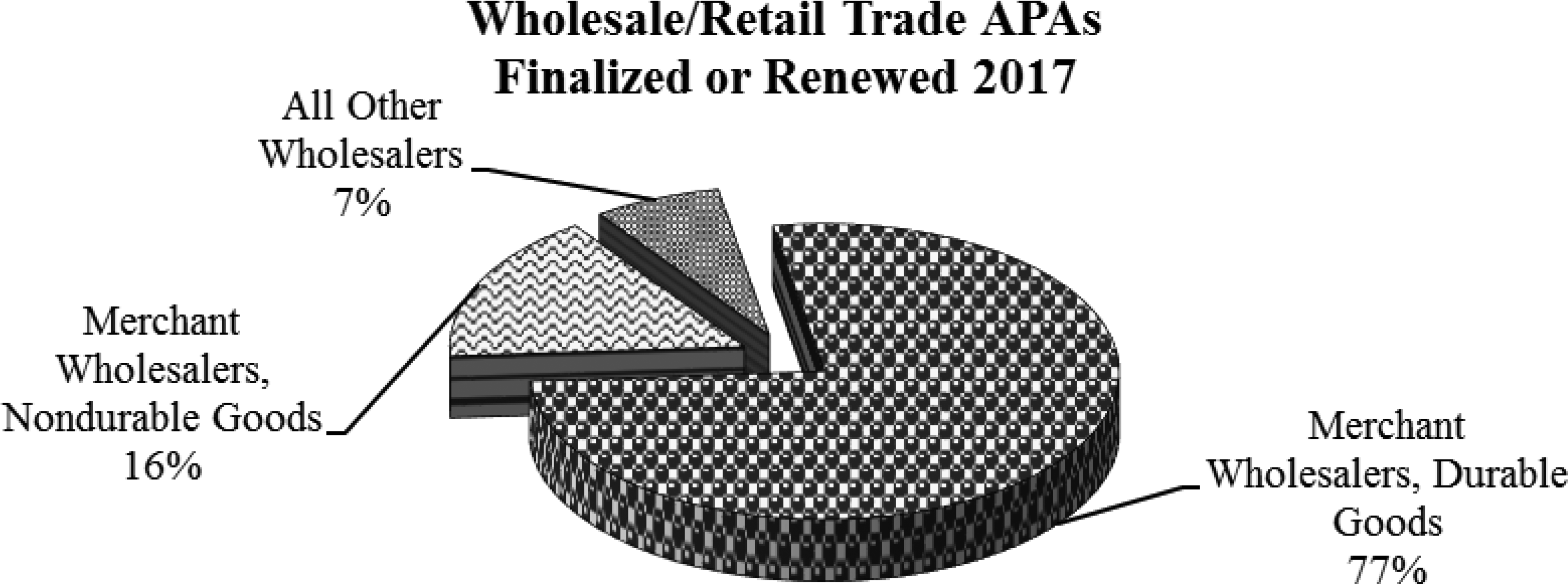
[Pub. L. 106–170 § 521(b)(2)(D) and (E)]
§ 521(b)(2)(D)(ii–iii)
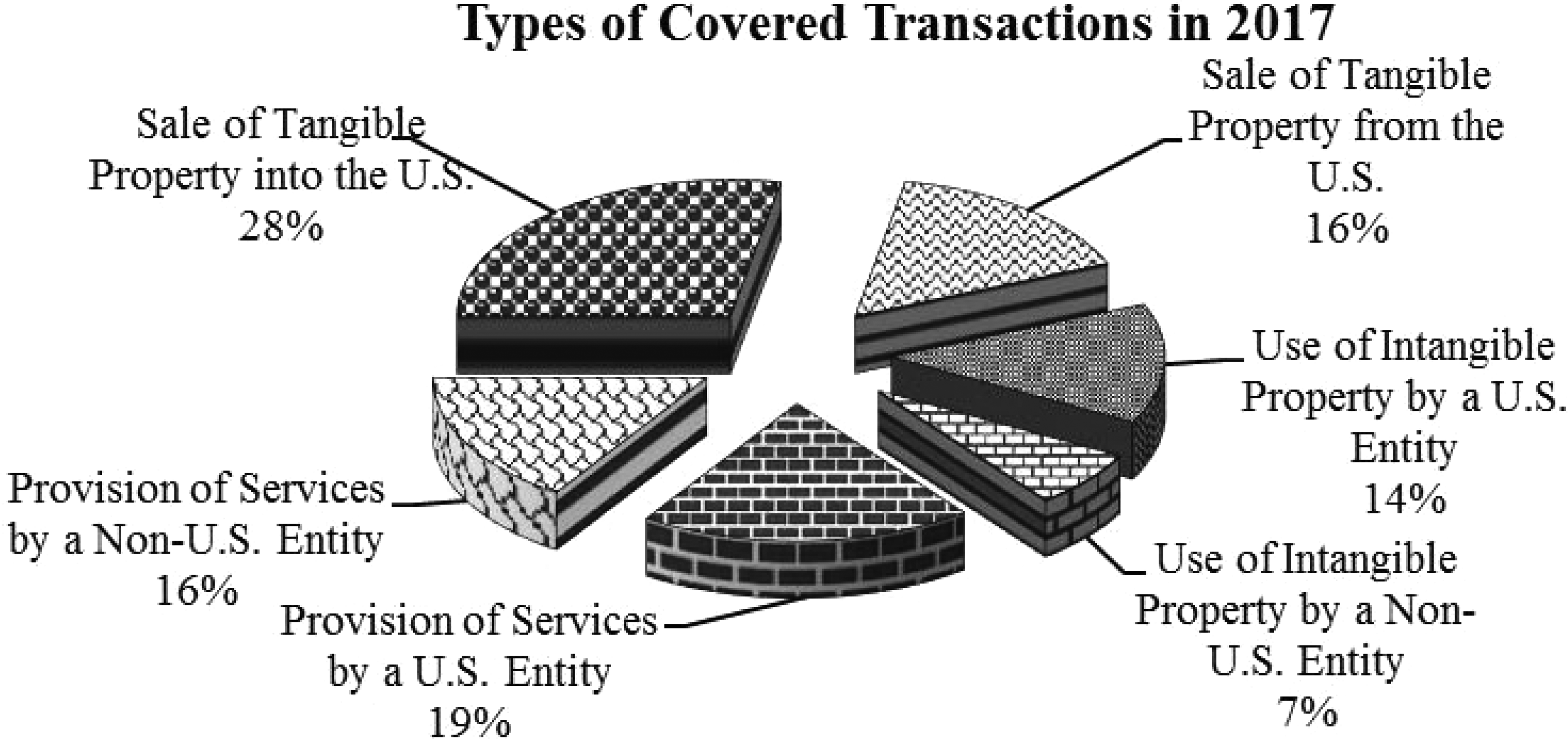
Although most of the transactions[3] covered in APAs executed in 2017 involve the sale of tangible goods and the provision of services, over 20% covered the use of intangible property, which can be among the most challenging in APMA’s inventory. The IRS continues to seek opportunities to work with taxpayers and treaty partners to provide prospective certainty, wherever appropriate, for transactions involving the use of intangible property.
In the majority of APAs, the covered transactions involve numerous business functions and risks. For instance, with respect to functions, APAs involving manufactured products typically involve a controlled group that conducts research and development (R&D), engages in product design and engineering, manufactures the product, markets and distributes the product, and performs support functions such as legal, finance, and human resources services. Regarding risks, the controlled group may assume a variety of risks, including market risks, R&D risks, financial risks, credit and collection risks, product liability risks, and general business risks. In the APA evaluation process, a significant amount of time and effort is devoted to understanding how the functions and risks are allocated amongst the controlled group of companies that are party to the covered transactions. Generally, for methods requiring selection of a tested party, the tested party that is chosen will be the least complex of the controlled taxpayers.
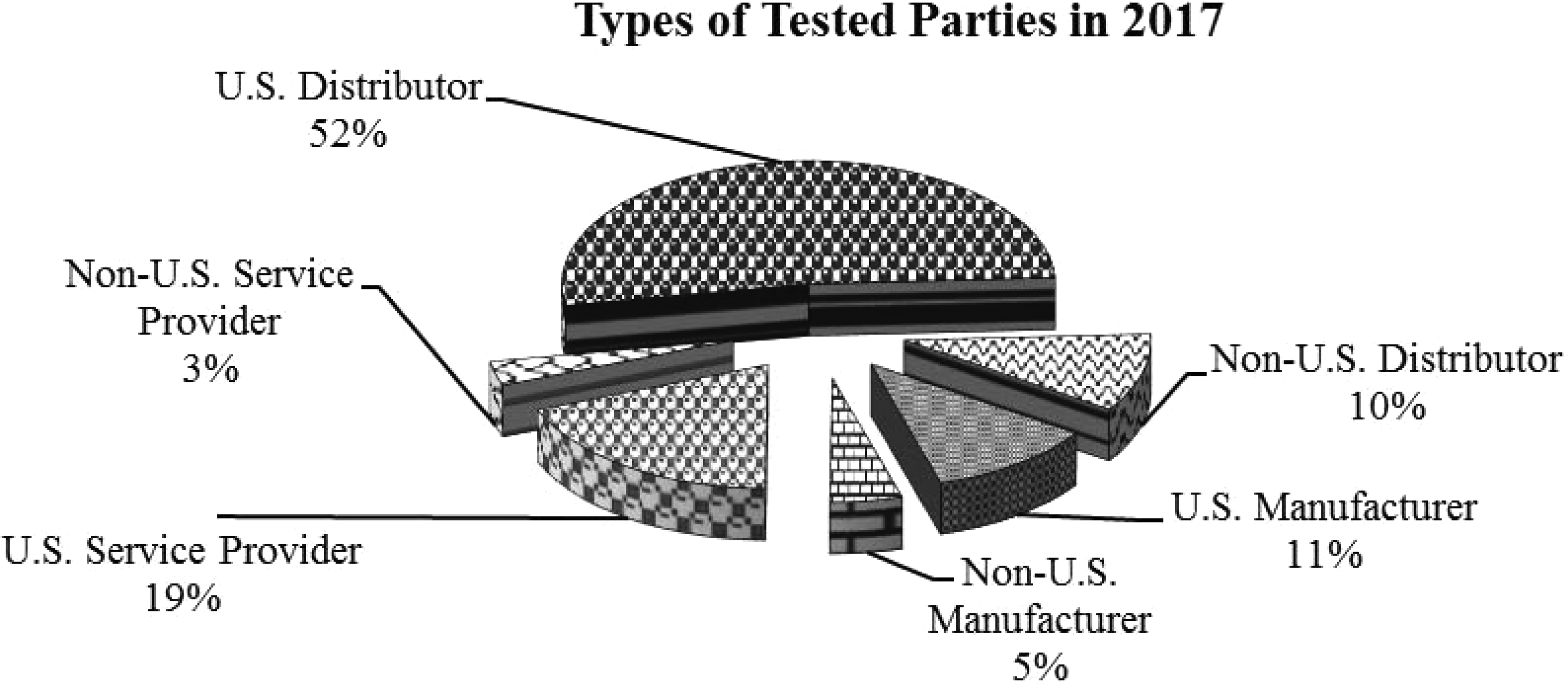
Over three quarters of the tested parties in 2017[4] were U.S. distributors, U.S. manufacturers, or U.S. service providers.
§ 521(b)(2)(D)(iv)
Consistent with prior years, in 2017, the primary transfer pricing method (TPM) used for both the sale of tangible property and the use of intangible property was the comparable profits method/transactional net margin method (CPM/TNMM). The CPM/TNMM was used for 87 percent of transfers of tangible and intangible property while all other methods combined accounted for the other 13 percent of such transactions.
For covered transfers of tangible and intangible property that used the CPM/TNMM, the operating margin (OM) continues to be the most common profit level indicator (PLI) used to benchmark results. It was used 85 percent of the time. Other PLIs, such as the Berry Ratio and return on assets or capital employed, made up the other 15 percent. As used here, OM means the ratio of operating profits to sales,[5] and “Berry Ratio” means the ratio of gross profit to operating expenses.[6] Most services transactions (86 percent) also used the CPM/TNMM, and the OM was also the most common PLI (used 62 percent of the time).[7]
§ 521(b)(2)(D)(v–vii)
For the APAs executed in 2017 that used external comparable data in the analysis, the most widely used data source for comparables was Standard and Poor’s Compustat/Capital IQ database. Other sources were also used in appropriate cases (e.g., where the tested party was not the U.S. entity or where transaction-based methods were applied). The other more commonly used databases are listed in the table below.
| Table 5: Sources of Comparable Data | |
|---|---|
| Avention (formerly known as OneSource) | Mergent |
| Bloomberg | Orbis |
| Disclosure | Recap |
| Global Vantage | RoyaltySource |
| ktMINE | RoyaltyStat |
| LoanConnector | Worldscope |
In making comparability adjustments, the standard balance sheet adjustments identified in Treas. Reg. § 1.482–1(d) and § 1.482–5(c), including adjustments for differing amounts of payables, receivables, and inventory, were made in the majority of cases. Where appropriate, adjustments for different accounting practices were made to convert from LIFO to FIFO inventory accounting, and a small number of cases also involved the accounting reclassification of expenses, e.g., from COGS to operating expenses.
§ 521(b)(2)(D)(viii–ix)
Most transactions covered in APAs target an interquartile range as described in Treas. Reg. § 1.482–1(e)(2)(iii)(C). Where the transaction involves a royalty payment for the use of intangible property, both specific royalty rates and ranges have been used. Where the covered transaction is the payment of a royalty based solely on external royalty agreements, a secondary method, e.g., a test of the post-royalty operating margin or cost-plus mark-up, has been used. The testing periods of the APAs executed in 2017 were either: (1) a single year, (2) the term of the APA only, or (3) the term of the APA plus rollback years.
APAs executed in 2017 included several mechanisms for making adjustments to tested party results when the results fall outside the range or do not match the point required by the APA. The following are examples of the mechanisms used: an adjustment bringing the tested party’s results to the closest edge of the range applied to the results of a single year; an adjustment to the closer edge of the range applied to the results over the APA term; an adjustment to the specified point or royalty rate; or an adjustment to the median of the range for a single year.
§ 521(b)(2)(D)(v)
The model APA used by the IRS (included as Appendix 1 of this report) includes a standard critical assumption that there will be no material changes to the taxpayer’s business or to its tax or financial accounting practices during the APA term. A few bilateral cases have also included critical assumptions tied either to the taxpayer’s profitability in a certain year or over the term of the APA, or to the amount of non-covered transactions as a percentage of the taxpayer’s revenue. Pursuant to § 7.06(3) of Rev. Proc. 2015–41, 2015 I.R.B. 263, APMA will cancel an APA in the event of a failure of a critical assumption unless the parties agree to revise the APA.
§ 521(b)(2)(D)(x)
| Table 6: Term Lengths of APAs Executed in 2017 | |
|---|---|
| Term Length (years) | Number of APAs |
| 2 | 1 |
| 3 | 3 |
| 4 | 6 |
| 5 | 38 |
| 6 | 9 |
| 7 | 16 |
| 8 | 16 |
| 9 | 11 |
| 10 | 6 |
| 11 | 5 |
| 12 | 2 |
| 13 | 2 |
| 14 | 1 |
| Average | 7 |
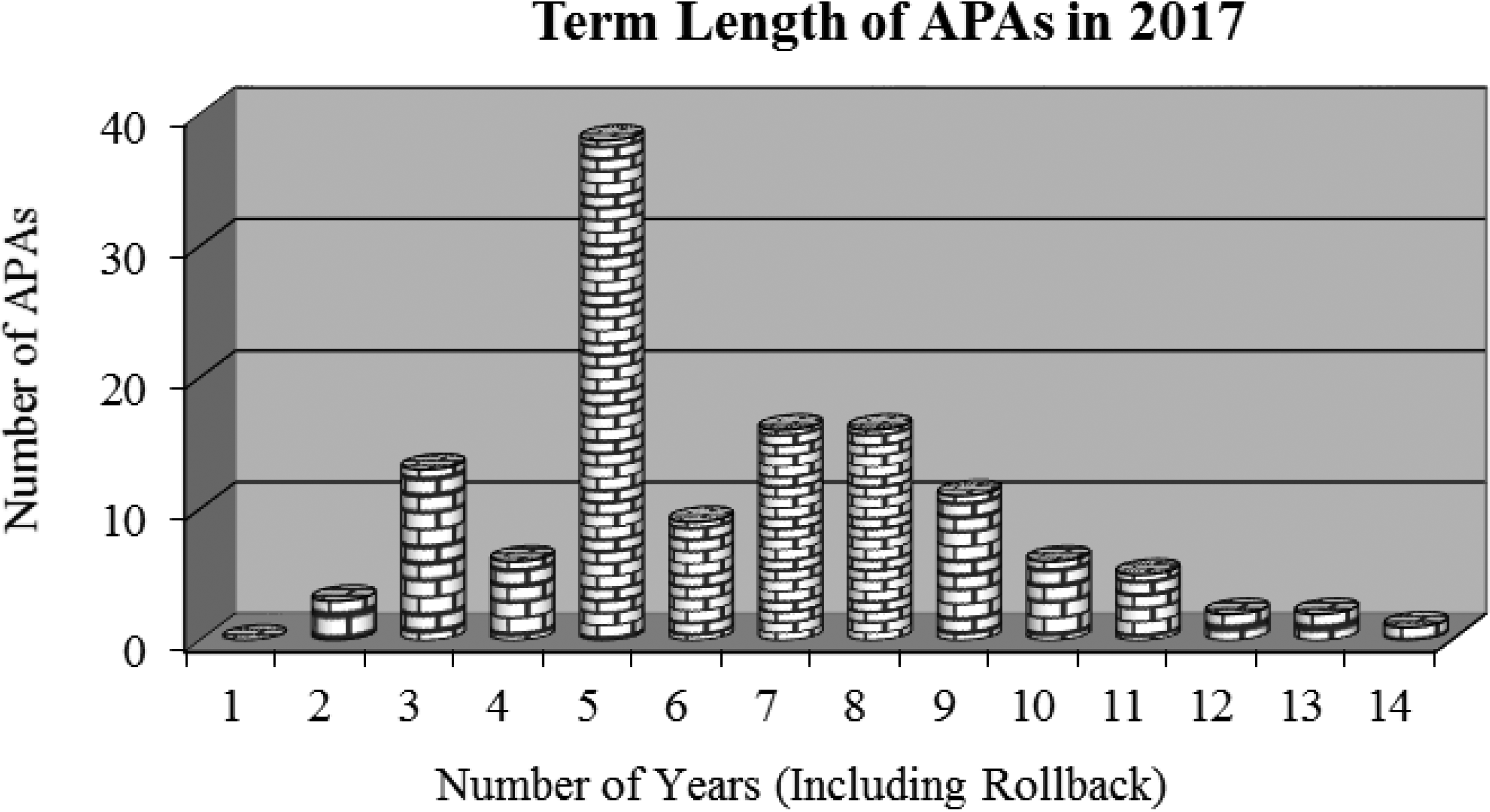
As described in § 3.03(1) of Rev. Proc. 2015–41, taxpayers should request an APA term that would cover at least five prospective years and may also request that the APA be “rolled back” to cover one or more earlier taxable years, although the appropriate APA term is decided on a case-by-case basis. Of the APAs executed in 2017, 22 percent included rollback years. A substantial number of those APAs with terms of greater than five years were submitted as a request for a five-year term, and the additional years were agreed to between the taxpayer and the IRS (or, in the case of a bilateral APA, between the IRS and the foreign government upon the taxpayer’s request) to ensure a reasonable amount of prospectivity in the APA term.
§ 521(b)(2)(E)
| Table 7: Months to Complete New and Renewal APAs Executed in 2017 | ||||||
|---|---|---|---|---|---|---|
| Unilateral | Bilateral | Unilateral & Bilateral | ||||
| Average | Median | Average | Median | Average | Median | |
| New | 40.4 | 34.8 | 46.9 | 50.0 | 45.5 | 43.0 |
| Renewal | 28.7 | 27.2 | 37.3 | 32.2 | 34.7 | 30.5 |
| New & Renewal | 32.6 | 31.0 | 41.5 | 35.9 | 39.1 | 33.8 |
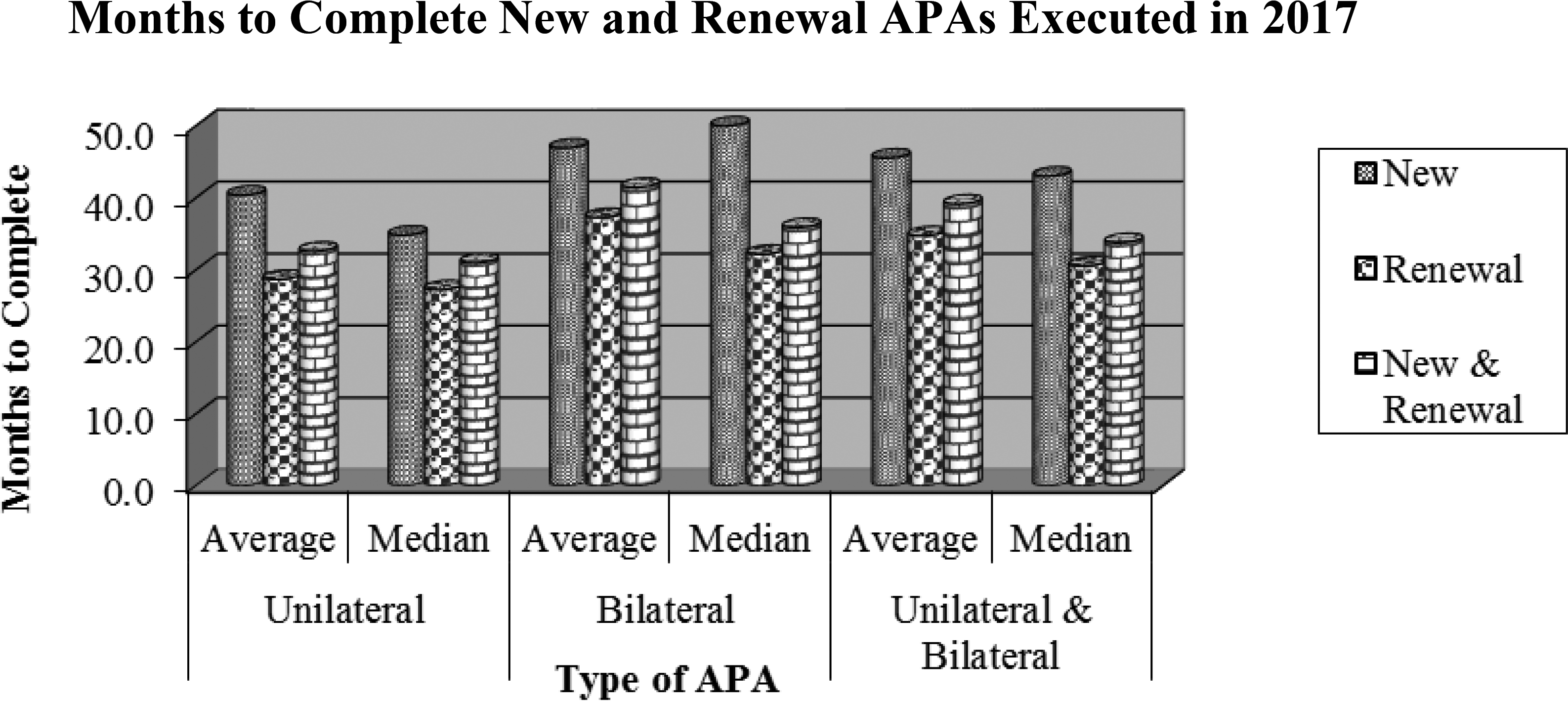
The median time required to complete an APA in 2017 increased slightly (32.8 months in 2016 versus 33.8 in 2017).
§ 521(b)(2)(F)
As described in § 7.02(1) of Rev. Proc. 2015–41, taxpayers are required to file annual reports to demonstrate compliance with the terms and conditions of their APA. The filing and review of these annual reports are critical parts of the APA process. Through annual report review, the APMA Program monitors taxpayer compliance with APAs on a contemporaneous basis. Annual report review also provides current information on the success or problems associated with the various TPMs adopted in the APA process.
§ 521(b)(2)(D)(xi)
APAs require taxpayers to file timely and complete annual reports describing their operations and demonstrating compliance with the APA’s terms and conditions. Not every annual report will include each of the items listed in the following table[8]; they are required where the facts demonstrate a need for such documentation.
| 1. | Statement regarding all material differences between Taxpayer’s business operations during APA year and description of Taxpayer’s business operations contained in Taxpayer’s APA request. If there are no material differences, a statement to that effect. |
|---|---|
| 2. | Statement concerning all material changes in Taxpayer’s accounting methods and classifications, and methods of estimation, from those described or used in Taxpayer’s request for the APA. If there has been no material change in accounting methods and classifications or methods of estimation, a statement to that effect. |
| 3. | Any change to the taxpayer notice information. |
| 4. | Description of any failure to meet critical assumptions. If there has been none, a statement to that effect. |
| 5. | Statement identifying whether or not any material information submitted while the APA request was pending is discovered to be false, incorrect, or incomplete. |
| 6. | The amount, reason for, and financial analysis of any compensating adjustment, for the APA year, including but not limited to: the amounts paid or received by each affected entity; the character (such as capital or ordinary expense) and country source of the funds transferred, and the specific line item(s) of any affected U.S. tax return; and any change to any entity classification for federal income tax purposes of any member of Taxpayer’s group that is relevant to the APA. |
| 7. | The amounts, description, reason for, and financial analysis of any book-tax difference relevant to the TPM for the APA year, as reflected on Schedule M-1 or Schedule M-3 of the U.S. return for the APA year. |
| 8. | Statement regarding whether Taxpayer contemplates requesting, or has requested, to renew, modify, or cancel the APA. |
| 9. | Financial statements and any necessary account detail to show compliance with the TPM, with a copy of the opinion from an independent certified public accountant or other documentation required by paragraph 5(f) of the APA. |
| 10. | Financial analysis demonstrating Taxpayer’s compliance with TPM. |
| 11. | Organizational chart. |
| 12. | A copy of the APA and any amendment. |
| 13. | A penalty of perjury statement. |
§ 521(b)(2)(D)(xii)
In appropriate cases, APAs may provide specific approaches for dealing with risks, including currency risk, such as adjustment mechanisms and/or critical assumptions.
The Parties to this Advance Pricing Agreement (APA) are the Internal Revenue Service (IRS) and [Insert Taxpayer’s Name], EIN ________.
[Insert Taxpayer Name] is the common parent of an affiliated group filing consolidated U.S. tax returns (collectively referred to as “Taxpayer”), and is entering into this APA on behalf of itself and other members of its consolidated group.
Taxpayer’s principal place of business is [City, State]. [Insert general description of taxpayer and other relevant parties].
This APA contains the Parties’ agreement on the best method for determining arm’s-length prices of the Covered Transactions under I.R.C. section 482, the Treasury Regulations thereunder, and any applicable tax treaties.
{If renewal, add} [Taxpayer and IRS previously entered into an APA covering taxable years ending _____ to ______, executed on ________.]
The Parties agree as follows:
-
1. Covered Transactions. This APA applies to the Covered Transactions, as defined in Appendix A.
-
2. Transfer Pricing Method. Appendix A sets forth the Transfer Pricing Method (TPM) for the Covered Transactions.
-
3. Term. This APA applies to the APA Term, as defined in Appendix A.
-
4. Operation.
-
a. Revenue Procedure 2006–9 governs the interpretation, legal effect, and administration of this APA.
-
b. Nonfactual oral and written representations, within the meaning of sections 10.04 and 10.05 of Revenue Procedure 2006–9 (including any proposals to use particular TPMs), made in conjunction with the APA Request constitute statements made in compromise negotiations within the meaning of Rule 408 of the Federal Rules of Evidence.
-
5. Compliance.
-
a. Taxpayer must report its taxable income in an amount that is consistent with Appendix A and all other requirements of this APA on its timely filed U.S. Return. However, if Taxpayer’s timely filed U.S. Return for any taxable year covered by this APA (APA Year) is filed prior to, or no later than 60 days after, the effective date of this APA, then Taxpayer must report its taxable income for that APA Year in an amount that is consistent with Appendix A and all other requirements of this APA either on the original U.S. Return or on an amended U.S. Return filed no later than 120 days after the effective date of this APA, or through such other means as may be specified herein.
-
b. {Use or edit the following when U.S. Group or Foreign Group contains more than one member.} [This APA addresses the arm’s-length nature of prices charged or received in the aggregate between Taxpayer and Foreign Participants with respect to the Covered Transactions. Except as explicitly provided, this APA does not address and does not bind the IRS with respect to prices charged or received, or the relative amounts of income or loss realized, by particular legal entities that are members of U.S. Group or that are members of Foreign Group.]
-
c. For each APA Year, if Taxpayer complies with the terms and conditions of this APA, then the IRS will not make or propose any allocation or adjustment under I.R.C. section 482 to the amounts charged in the aggregate between Taxpayer and Foreign Participant[s] with respect to the Covered Transactions.
-
d. If Taxpayer does not comply with the terms and conditions of this APA, then the IRS may:
-
i. enforce the terms and conditions of this APA and make or propose allocations or adjustments under I.R.C. section 482 consistent with this APA;
-
ii. cancel or revoke this APA under section 11.06 of Revenue Procedure 2006–9; or
-
iii. revise this APA, if the Parties agree.
-
e. Taxpayer must timely file an Annual Report (an original and four copies) for each APA Year in accordance with Appendix C and section 11.01 of Revenue Procedure 2006–9. Taxpayer must file the Annual Report for all APA Years through the APA Year ending [insert year] by [insert date]. Taxpayer must file the Annual Report for each subsequent APA Year by [insert month and day] immediately following the close of that APA Year. (If any date falls on a weekend or holiday, the Annual Report shall be due on the next date that is not a weekend or holiday.) The IRS may request additional information reasonably necessary to clarify or complete the Annual Report. Taxpayer will provide such requested information within 30 days. Additional time may be allowed for good cause.
-
f. The IRS will determine whether Taxpayer has complied with this APA based on Taxpayer’s U.S. Returns, the Financial Statements, and other APA Records, for the APA Term and any other year necessary to verify compliance. For Taxpayer to comply with this APA, {use the following or an alternative} an independent certified public accountant must render an opinion that Taxpayer’s Financial Statements present fairly, in all material respects, Taxpayer’s financial position under U.S. GAAP.
-
g. In accordance with section 11.04 of Revenue Procedure 2006–9, Taxpayer will (1) maintain the APA Records, and (2) make them available to the IRS in connection with an examination under section 11.03. Compliance with this subparagraph constitutes compliance with the record-maintenance provisions of I.R.C. sections 6038A and 6038C for the Covered Transactions for any taxable year during the APA Term.
-
h. The True Taxable Income within the meaning of Treasury Regulations sections 1.482–1(a)(1) and (i)(9) of a member of an affiliated group filing a U.S. consolidated return will be determined under the I.R.C. section 1502 Treasury Regulations.
-
i. {Optional for US Parent Signatories} To the extent that Taxpayer’s compliance with this APA depends on certain acts of Foreign Group members, Taxpayer will ensure that each Foreign Group member will perform such acts.
-
6. Critical Assumptions. This APA’s critical assumptions, within the meaning of Revenue Procedure 2006–9, section 4.05, appear in Appendix B. If any critical assumption has not been met, then Revenue Procedure 2006–9, section 11.06, governs.
-
7. Disclosure. This APA, and any background information related to this APA or the APA Request, are: (1) considered “return information” under I.R.C. section 6103(b)(2)(C); and (2) not subject to public inspection as a “written determination” under I.R.C. section 6110(b)(1). Section 521(b) of Pub. L. 106–170 provides that the Secretary of the Treasury must prepare a report for public disclosure that includes certain specifically designated information concerning all APAs, including this APA, in a form that does not reveal taxpayers’ identities, trade secrets, and proprietary or confidential business or financial information.
-
8. Disputes. If a dispute arises concerning the interpretation of this APA, the Parties will seek a resolution by the Director of the Advance Pricing and Mutual Agreement Program, to the extent reasonably practicable, before seeking alternative remedies.
-
9. Materiality. In this APA the terms “material” and “materially” will be interpreted consistently with the definition of “material facts” in Revenue Procedure 2006–9, section 11.06(4).
-
10. Section Captions. This APA’s section captions, which appear in italics, are for convenience and reference only. The captions do not affect in any way the interpretation or application of this APA.
-
11. Terms and Definitions. Unless otherwise specified, terms in the plural include the singular and vice versa. Appendix D contains definitions for capitalized terms not elsewhere defined in this APA.
-
12. Entire Agreement and Severability. This APA is the complete statement of the Parties’ agreement. The Parties will sever, delete, or reform any invalid or unenforceable provision in this APA to approximate the Parties’ intent as nearly as possible.
-
13. Successor in Interest. This APA binds, and inures to the benefit of, any successor in interest to Taxpayer.
-
14. Notice. Any notices required by this APA or Revenue Procedure 2006–9 must be in writing. Taxpayer will send notices to the IRS at the address and in the manner set forth in Revenue Procedure 2006–9, section 4.11. The IRS will send notices to:
-
Taxpayer Corporation
-
Attn: Jane Doe, Sr. Vice President (Taxes)
-
1000 Any Road
-
Any City, USA 10000
-
(phone: _________)
-
15. Effective Date and Counterparts. This APA is effective starting on the date, or later date of the dates, upon which all Parties execute this APA. The Parties may execute this APA in counterparts, with each counterpart constituting an original.
The Parties have executed this APA on the dates below.
[Taxpayer Name in all caps]
By: ___________________________ Date: ___________________, 201___
Jane Doe
Sr. Vice President (Taxes)
IRS
By: ___________________________ Date: ___________________, 201___
John C. C. Hughes
Director, Advance Pricing and Mutual Agreement Program
COVERED TRANSACTIONS AND TRANSFER PRICING METHOD (TPM)
-
1. Covered Transactions.
-
[Define the Covered Transactions.]
-
2. APA Term.
-
This APA applies to Taxpayer’s taxable years ending __________ through ________ (APA Term).
-
3. TPM.
-
{Note: If appropriate, adapt language from the following examples.}
-
[The Tested Party is __________.]
-
CUP Method
-
The TPM is the comparable uncontrolled price (CUP) method. The Arm’s Length Range of the price charged for _________ is between _______ and ___________ per unit.
-
CUT Method
-
The TPM is the CUT Method. The Arm’s Length Range of the royalty charged for the license of ______is between ____% and ___ % of [Taxpayer’s, Foreign Participants’, or other specified party’s] Net Sales Revenue. [Insert definition of net sales revenue or other royalty base.]
-
Resale Price Method (RPM)
-
The TPM is the resale price method (RPM). The Tested Party’s Gross Margin for any APA Year is defined as follows: the Tested Party’s gross profit divided by its sales revenue (as those terms are defined in Treasury Regulations sections 1.482–5(d)(1) and (2)) for that APA Year. The Arm’s Length Range is between ____% and ___ %, and the Median of the Arm’s Length Range is ___%.
-
Cost Plus Method
-
The TPM is the cost plus method. The Tested Party’s Cost Plus Markup is defined as follows for any APA Year: the Tested Party’s ratio of gross profit to production costs (as those terms are defined in Treasury Regulations sections 1.482–3(d)(1) and (2)) for that APA Year. The Arm’s Length Range is between ___% and ___%, and the Median of the Arm’s Length Range is ___%.
-
CPM with Berry Ratio PLI
-
The TPM is the comparable profits method (CPM). The profit level indicator is a Berry Ratio. The Tested Party’s Berry Ratio is defined as follows for any APA Year: the Tested Party’s gross profit divided by its operating expenses (as those terms are defined in Treasury Regulations sections 1.482–5(d)(2) and (3)) for that APA Year. The Arm’s Length Range is between ____ and ___, and the Median of the Arm’s Length Range is ___.
-
CPM using an Operating Margin PLI
-
The TPM is the comparable profits method (CPM). The profit level indicator is an operating margin. The Tested Party’s Operating Margin is defined as follows for any APA Year: the Tested Party’s operating profit divided by its sales revenue (as those terms are defined in Treasury Regulations section 1.482–5(d)(1) and (4)) for that APA Year. The Arm’s Length Range is between ____% and ___ %, and the Median of the Arm’s Length Range is ___%.
-
CPM using a Three-year Rolling Average Operating Margin PLI
-
The TPM is the comparable profits method (CPM). The profit level indicator is an operating margin. The Tested Party’s Three-Year Rolling Average operating margin is defined as follows for any APA Year: the sum of the Tested Party’s operating profit (within the meaning of Treasury Regulation section 1.482–5(d)(4) for that APA Year and the two preceding years, divided by the sum of its sales revenue (within the meaning of Treasury Regulation section 1.482–5(d)(1)) for that APA Year and the two preceding years. The Arm’s Length Range is between ____% and ____%, and the Median of the Arm’s Length Range is ___%.
-
Residual Profit Split Method
-
The TPM is the residual profit split method. [Insert description of routine profit level determinations and residual profit-split mechanism].
-
[Insert additional provisions as needed.]
-
4. Application of TPM.
For any APA Year, if the results of Taxpayer’s actual transactions produce a [price per unit, royalty rate for the Covered Transactions] [or] [Gross Margin, Cost Plus Markup, Berry Ratio, Operating Margin, Three-Year Rolling Average Operating Margin for the Tested Party] within the Arm’s Length Range, then the amounts reported on Taxpayer’s U.S. Return must clearly reflect such results.
For any APA year, if the results of Taxpayer’s actual transactions produce a [price per unit, royalty rate] [or] [Gross Margin, Cost Plus Markup, Berry Ratio, Operating Margin, Three-Year Rolling Average Operating Margin for the Tested Party] outside the Arm’s Length Range, then amounts reported on Taxpayer’s U.S. Return must clearly reflect an adjustment that brings the [price per unit, royalty rate] [or] [Tested Party’s Gross Margin, Cost Plus Markup, Berry Ratio, Operating Margin, Three-Year Rolling Average Operating Margin] to the Median.
For purposes of this Appendix A, the “results of Taxpayer’s actual transactions” means the results reflected in Taxpayer’s and Tested Party’s books and records as computed under U.S. GAAP [insert another relevant accounting standard if applicable], with the following adjustments:
(a) [The fair value of stock-based compensation as disclosed in the Tested Party’s audited financial statements shall be treated as an operating expense]; and
(b) To the extent that the results in any prior APA Year are relevant (for example, to compute a multi-year average), such results shall be adjusted to reflect the amount of any adjustment made for that prior APA Year under this Appendix A.
5. APA Revenue Procedure Treatment
If Taxpayer makes an adjustment under paragraph 4 of this Appendix A (a “primary adjustment”), Taxpayer and its related foreign entity may elect APA Revenue Procedure Treatment in accordance with section 11.02(3) of Revenue Procedure 2006–9 and avoid the possible adverse tax consequences of a secondary adjustment that would otherwise follow the primary adjustment.
[Insert additional provisions as needed.]
CRITICAL ASSUMPTIONS
This APA’s critical assumptions are:
1. The business activities, functions performed, risks assumed, assets employed, and financial and tax accounting methods and classifications [and methods of estimation] of Taxpayer in relation to the Covered Transactions will remain materially the same as described or used in Taxpayer’s APA Request. A mere change in business results will not be a material change.
[Insert additional provisions as needed.]
The APA Records will consist of all documents listed below for inclusion in the Annual Report, as well as all documents, notes, work papers, records, or other writings that support the information provided in such documents.
The Annual Report (and each of the four copies required by paragraph 5(e) of this APA) will include:
-
1. Two copies of a properly completed APA Annual Report Summary in the form of Appendix E to this APA, one copy of the form bound with, and one copy provided separately from, the rest of the Annual Report.
-
2. A table of contents, organized as follows:
-
3. Statements that fully identify, describe, analyze, and explain:
-
a. All material differences between the U.S. Group’s business operations (including functions, risks assumed, markets, contractual terms, economic conditions, property, services, and assets employed) during the APA Year from the business operations described in the APA Request. If there have been no material differences, the Annual Report will include a statement to that effect.
-
b. All material differences between the U.S. Group’s accounting methods and classifications, and methods of estimation used during the APA Year, from those described or used in the APA Request. If any change was made to conform to changes in U.S. GAAP (or other relevant accounting standards) Taxpayer will specifically identify the change. If there has been no material change in accounting methods and classifications or methods of estimation, the Annual Report will include a statement to that effect.
-
c. Any change to the Taxpayer notice information in paragraph 14 of this APA.
-
d. Any failure to meet any critical assumption. If there has been no failure, the Annual Report will include a statement to that effect.
-
e. Whether or not material information submitted while the APA Request was pending is discovered to be false, incorrect, or incomplete.
-
f. Any change to any entity classification for federal income tax purposes (including any change that causes an entity to be disregarded for federal income tax purposes) of any Worldwide Group member that is a party to the Covered Transactions or is otherwise relevant to the TPM.
-
The amount, reason for, and financial analysis of (1) any primary adjustments made under Appendix A for the APA Year; and (2) any (a) secondary adjustments that follow such primary adjustments or (b) accounts receivable that Taxpayer establishes, in lieu of secondary adjustments, by electing APA Revenue Procedure Treatment pursuant to paragraph 5 of Appendix A and Revenue Procedure 2006–9, section 11.02(3), for the APA Year, including but not limited to:
-
i. the amounts due or owed, and paid or received by each affected entity;
-
ii. the character (such as capital, ordinary, income, expense) and country source of the funds transferred, and the specific affected line item(s) of any affected U.S. Return;
-
iii. the date(s) and means by which the payments are or will be made; and
-
iv. whether or not APA Revenue Procedure Treatment was elected pursuant to paragraph 5 of Appendix A and Revenue Procedure 2006–9, section 11.02(3).
-
h. The amounts, description, reason for, and financial analysis of any book-tax difference relevant to the TPM for the APA Year, as reflected on Schedule M-1 or Schedule M-3 of the U.S. Return for the APA Year.
-
i. Whether Taxpayer contemplates requesting, or has requested, to renew, modify, or cancel the APA.
-
4. The Financial Statements, and any necessary account detail to show compliance with the TPM, including consolidating financial statements, segmented financial data, records from the general ledger, or similar information if the assets, liabilities, income, or expenses relevant to showing compliance with the TPM are a subset of the assets, liabilities, income, or expenses presented in the Financial Statements.
-
5. {Use the following or the alternative prescribed by paragraph 5(f) of this APA:} A copy of the independent certified public accountant’s opinion required by paragraph 5(f) of this APA.
-
6. A financial analysis that reflects Taxpayer’s TPM calculations for the APA Year. The calculations must reconcile with and reference the information required under item 4 above in sufficient account detail to allow the IRS to determine whether Taxpayer has complied with the TPM.
-
7. An organizational chart for the Worldwide Group, revised annually to reflect all ownership or structural changes of entities that are parties to the Covered Transactions or are otherwise relevant to the TPM.
-
8. A copy of the APA and any amendment.
-
9. A penalty of perjury statement, executed in accordance with Revenue Procedure 2006–9, section 11.01(6) and (7).
DEFINITIONS
The following definitions control for all purposes of this APA. The definitions appear alphabetically below:
| Term | Definition |
|---|---|
| Annual Report | A report within the meaning of Revenue Procedure 2006–9, section 11.01. |
| APA | This Advance Pricing Agreement, which is an “advance pricing agreement” within the meaning of Revenue Procedure 2006–9, section 2.04. |
| APA Records | The records specified in Appendix C. |
| APA Request | Taxpayer’s request for this APA dated _________, including any amendments or supplemental or additional information thereto. |
| APA Year | This term is defined in paragraph 5(a) of this APA. |
| Covered Transaction(s) | This term is defined in Appendix A. |
| Financial Statements | Financial statements prepared in accordance with U.S. GAAP and stated in U.S. dollars. |
| Foreign Group | Worldwide Group members that are not U.S. persons. |
| Foreign Participants | [name the foreign entities involved in Covered Transactions]. |
| I.R.C. | The Internal Revenue Code of 1986, 26 U.S.C., as amended. |
| Pub. L. 106–170 | The Ticket to Work and Work Incentives Improvement Act of 1999. |
| Revenue Procedure 2006–9 | Rev. Proc. 2006–9, 2006–1 C.B. 278. |
| Transfer Pricing Method (TPM) | A transfer pricing method within the meaning of Treasury Regulation section 1.482–1(b) and Revenue Procedure 2006–9, section 2.04. |
| U.S. GAAP | U.S. generally-accepted accounting principles. |
| U.S. Group | Worldwide Group members that are U.S. persons. |
| U.S. Return | For each taxable year, the “returns with respect to income taxes under subtitle A” that Taxpayer must “make” in accordance with I.R.C. section 6012. {Or substitute for partnership: For each taxable year, the “return” that Taxpayer must “make” in accordance with I.R.C. section 6031.} |
| Worldwide Group | Taxpayer and all organizations, trades, businesses, entities, or branches (whether or not incorporated, organized in the United States, or affiliated) owned or controlled directly or indirectly by the same interests. |
The APA Annual Report Summary on the next page is a required APA Record. The APA Team Leader supplies some of the information requested on the form. Taxpayer is to supply the remaining information requested by the form and submit the form as part of its Annual Report.
| APA Annual Report | Department of the Treasury—Internal Revenue Service | APA No. _______________ | ||
| SUMMARY | Large Business and International Division | Team Leader ____________________________ | ||
| Treaty and Transfer Pricing Operations | Economist _______________________________ | |||
| Advance Pricing and Mutual Agreement Program | Intl Examiner _____________________________ | |||
| APA Information | Taxpayer Name: ___________________________________________________ | |||
| Taxpayer EIN:_________________ NAICS:___________________ | ||||
| APA Term: Taxable years ending ________ to ____________ | ||||
| Original APA [ ] Renewal APA [ ] | ||||
| Annual Report due dates: | ||||
| _________________, 201__ for all APA Years through APA Year ending in 200__; for each APA Year | ||||
| thereafter, on _________________ [month and day] immediately following the close of the APA Year | ||||
| Principal foreign country(ies) involved in covered transaction(s): _______________________________________ | ||||
| Type of APA: [ ] unilateral [ ] bilateral with ________________ | ||||
| Tested party is [ ] US [ ] foreign [ ] both | ||||
| Approximate dollar volume of covered transactions (on an annual basis) involving tangible goods and services: | ||||
| [ ] N/A [ ] <$50 million [ ] $50–100 million [ ] $100–250 million [ ] $250–500 million [ ] >$500 million | ||||
| APA tests on (check all that apply): | ||||
| [ ] annual basis [ ] multi-year basis [ ] term basis | ||||
| APA provides (check all that apply) a: | ||||
| [ ] range [ ] point [ ] floor only [ ] ceiling only [ ] other_____________ | ||||
| APA provides for adjustment (check all that apply) to: | ||||
| [ ] nearest edge [ ] median [ ] other point | ||||
| APA Annual Report | APA date executed: ______________, 201__ | |||
| Information | This APA Annual Report Summary is for APA Year(s) ending in 200__ and was filed on _____________, 201__ | |||
| (to be completed by the Taxpayer) | Check here [ ] if Annual Report was filed after original due date but in accordance with extension. | |||
| Has this APA been amended or changed? [ ] yes [ ] no | Effective Date: ______________________ | |||
| Has Taxpayer complied with all APA terms and conditions? [ ] yes [ ] no | ||||
| Were all the critical assumptions met? [ ] yes [ ] no | ||||
| Has a Primary Compensating Adjustment been made in any APA Year covered by this Annual Report? | ||||
| [ ] yes [ ] no If yes, which year(s): 200___ | ||||
| Have any necessary Secondary Compensating Adjustments been made? [ ] yes [ ] no | ||||
| Did Taxpayer elect APA Revenue Procedure treatment? [ ] yes [ ] no | ||||
| Any change to the entity classification of a party to the APA? [ ] yes [ ] no | ||||
| Taxpayer notice information contained in the APA remains unchanged? [ ] yes [ ] no | ||||
| Taxpayer’s current US principal place of business: (City, State) _____________________________________ | ||||
| APA Annual Report | Financial analysis reflecting TPM calculations | [ ] yes [ ] no | ||
| Checklist of | Financial statements showing compliance with TPM(s) | [ ] yes [ ] no | ||
| Key Contents | Schedule M-1 or M-3 book-tax differences | [ ] yes [ ] no | ||
| (to be completed by the Taxpayer) | Current organizational chart of relevant portion of world-wide group | [ ] yes [ ] no | ||
| Attach copy of APA | [ ] yes [ ] no | |||
| Other APA records and documents included: | ||||
| Contact Information | Authorized Representative | Phone Number | Affiliation and Address | |
[2] In 2017, Transfer Pricing Operations became Treaty & Transfer Pricing Operations (TTPO).
[3] APAs often cover more than one type of transaction.
[4] Not all APAs executed in 2017 involved a tested party.
[5] See Treas. Reg. § 1.482–5(b)(4)(ii)(A).
[6] See Treas. Reg. § 1.482–5(b)(4)(ii)(B).
[7] In 2017, the majority of the APAs that covered services transactions also included tangible/intangible transactions, which were not tested under a separate PLI.
[8] The source of this list is the 2009 APA Model Agreement.
Revenue rulings and revenue procedures (hereinafter referred to as “rulings”) that have an effect on previous rulings use the following defined terms to describe the effect:
Amplified describes a situation where no change is being made in a prior published position, but the prior position is being extended to apply to a variation of the fact situation set forth therein. Thus, if an earlier ruling held that a principle applied to A, and the new ruling holds that the same principle also applies to B, the earlier ruling is amplified. (Compare with modified, below).
Clarified is used in those instances where the language in a prior ruling is being made clear because the language has caused, or may cause, some confusion. It is not used where a position in a prior ruling is being changed.
Distinguished describes a situation where a ruling mentions a previously published ruling and points out an essential difference between them.
Modified is used where the substance of a previously published position is being changed. Thus, if a prior ruling held that a principle applied to A but not to B, and the new ruling holds that it applies to both A and B, the prior ruling is modified because it corrects a published position. (Compare with amplified and clarified, above).
Obsoleted describes a previously published ruling that is not considered determinative with respect to future transactions. This term is most commonly used in a ruling that lists previously published rulings that are obsoleted because of changes in laws or regulations. A ruling may also be obsoleted because the substance has been included in regulations subsequently adopted.
Revoked describes situations where the position in the previously published ruling is not correct and the correct position is being stated in a new ruling.
Superseded describes a situation where the new ruling does nothing more than restate the substance and situation of a previously published ruling (or rulings). Thus, the term is used to republish under the 1986 Code and regulations the same position published under the 1939 Code and regulations. The term is also used when it is desired to republish in a single ruling a series of situations, names, etc., that were previously published over a period of time in separate rulings. If the new ruling does more than restate the substance of a prior ruling, a combination of terms is used. For example, modified and superseded describes a situation where the substance of a previously published ruling is being changed in part and is continued without change in part and it is desired to restate the valid portion of the previously published ruling in a new ruling that is self contained. In this case, the previously published ruling is first modified and then, as modified, is superseded.
Supplemented is used in situations in which a list, such as a list of the names of countries, is published in a ruling and that list is expanded by adding further names in subsequent rulings. After the original ruling has been supplemented several times, a new ruling may be published that includes the list in the original ruling and the additions, and supersedes all prior rulings in the series.
Suspended is used in rare situations to show that the previous published rulings will not be applied pending some future action such as the issuance of new or amended regulations, the outcome of cases in litigation, or the outcome of a Service study.
The following abbreviations in current use and formerly used will appear in material published in the Bulletin.
A—Individual.
Acq.—Acquiescence.
B—Individual.
BE—Beneficiary.
BK—Bank.
B.T.A.—Board of Tax Appeals.
C—Individual.
C.B.—Cumulative Bulletin.
CFR—Code of Federal Regulations.
CI—City.
COOP—Cooperative.
Ct.D.—Court Decision.
CY—County.
D—Decedent.
DC—Dummy Corporation.
DE—Donee.
Del. Order—Delegation Order.
DISC—Domestic International Sales Corporation.
DR—Donor.
E—Estate.
EE—Employee.
E.O.—Executive Order.
ER—Employer.
ERISA—Employee Retirement Income Security Act.
EX—Executor.
F—Fiduciary.
FC—Foreign Country.
FICA—Federal Insurance Contributions Act.
FISC—Foreign International Sales Company.
FPH—Foreign Personal Holding Company.
F.R.—Federal Register.
FUTA—Federal Unemployment Tax Act.
FX—Foreign corporation.
G.C.M.—Chief Counsel’s Memorandum.
GE—Grantee.
GP—General Partner.
GR—Grantor.
IC—Insurance Company.
I.R.B.—Internal Revenue Bulletin.
LE—Lessee.
LP—Limited Partner.
LR—Lessor.
M—Minor.
Nonacq.—Nonacquiescence.
O—Organization.
P—Parent Corporation.
PHC—Personal Holding Company.
PO—Possession of the U.S.
PR—Partner.
PRS—Partnership.
PTE—Prohibited Transaction Exemption.
Pub. L.—Public Law.
REIT—Real Estate Investment Trust.
Rev. Proc.—Revenue Procedure.
Rev. Rul.—Revenue Ruling.
S—Subsidiary.
S.P.R.—Statement of Procedural Rules.
Stat.—Statutes at Large.
T—Target Corporation.
T.C.—Tax Court.
T.D.—Treasury Decision.
TFE—Transferee.
TFR—Transferor.
T.I.R.—Technical Information Release.
TP—Taxpayer.
TR—Trust.
TT—Trustee.
U.S.C.—United States Code.
X—Corporation.
Y—Corporation.
Z—Corporation.
A cumulative list of all revenue rulings, revenue procedures, Treasury decisions, etc., published in Internal Revenue Bulletins 2017–27 through 2017–52 is in Internal Revenue Bulletin 2017–52, dated December 27, 2017.
Bulletin 2018–1 through 2018–19
Notices:
| Article | Issue | Link | Page |
|---|---|---|---|
| 2018-01 | 2018-03 I.R.B. | 2018-03 | 285 |
| 2018-02 | 2018-02 I.R.B. | 2018-02 | 281 |
| 2018-03 | 2018-02 I.R.B. | 2018-02 | 285 |
| 2018-05 | 2018-06 I.R.B. | 2018-06 | 341 |
| 2018-06 | 2018-03 I.R.B. | 2018-03 | 300 |
| 2018-07 | 2018-04 I.R.B. | 2018-04 | 317 |
| 2018-08 | 2018-07 I.R.B. | 2018-07 | 352 |
| 2018-10 | 2018-08 I.R.B. | 2018-08 | 359 |
| 2018-11 | 2018-11 I.R.B. | 2018-11 | 425 |
| 2018-12 | 2018-12 I.R.B. | 2018-12 | 441 |
| 2018-13 | 2018-06 I.R.B. | 2018-06 | 341 |
| 2018-14 | 2018-07 I.R.B. | 2018-07 | 353 |
| 2018-15 | 2018-09 I.R.B. | 2018-09 | 376 |
| 2018-16 | 2018-10 I.R.B. | 2018-10 | 390 |
| 2018-17 | 2018-09 I.R.B. | 2018-09 | 376 |
| 2018-18 | 2018-12 I.R.B. | 2018-12 | 443 |
| 2018-19 | 2018-12 I.R.B. | 2018-12 | 443 |
| 2018-20 | 2018-12 I.R.B. | 2018-12 | 444 |
| 2018-21 | 2018-15 I.R.B. | 2018-15 | 472 |
| 2018-22 | 2018-14 I.R.B. | 2018-14 | 464 |
| 2018-23 | 2018-15 I.R.B. | 2018-15 | 474 |
| 2018-24 | 2018-17 I.R.B. | 2018-17 | 507 |
| 2018-25 | 2018-15 I.R.B. | 2018-15 | 476 |
| 2018-26 | 2018-16 I.R.B. | 2018-16 | 480 |
| 2018-28 | 2018-16 I.R.B. | 2018-16 | 492 |
| 2018-29 | 2018-16 I.R.B. | 2018-16 | 495 |
| 2018-31 | 2018-16 I.R.B. | 2018-16 | 501 |
| 2018-32 | 2018-17 I.R.B. | 2018-17 | 507 |
| 2018-33 | 2018-17 I.R.B. | 2018-17 | 508 |
| 2018-34 | 2018-19 I.R.B. | 2018-19 | 549 |
| 2018-35 | 2018-18 I.R.B. | 2018-18 | 520 |
| 2018-37 | 2018-18 I.R.B. | 2018-18 | 521 |
| 2018-38 | 2018-18 I.R.B. | 2018-18 | 522 |
Revenue Procedures:
| Article | Issue | Link | Page |
|---|---|---|---|
| 2018-1 | 2018-01 I.R.B. | 2018-01 | 1 |
| 2018-2 | 2018-01 I.R.B. | 2018-01 | 106 |
| 2018-3 | 2018-01 I.R.B. | 2018-01 | 130 |
| 2018-4 | 2018-01 I.R.B. | 2018-01 | 146 |
| 2018-5 | 2018-01 I.R.B. | 2018-01 | 244 |
| 2018-7 | 2018-01 I.R.B. | 2018-01 | 282 |
| 2018-8 | 2018-02 I.R.B. | 2018-02 | 286 |
| 2018-9 | 2018-02 I.R.B. | 2018-02 | 290 |
| 2018-10 | 2018-07 I.R.B. | 2018-07 | 355 |
| 2018-11 | 2018-05 I.R.B. | 2018-05 | 334 |
| 2018-12 | 2018-06 I.R.B. | 2018-06 | 349 |
| 2018-13 | 2018-07 I.R.B. | 2018-07 | 356 |
| 2018-14 | 2018-09 I.R.B. | 2018-09 | 378 |
| 2018-15 | 2018-09 I.R.B. | 2018-09 | 379 |
| 2018-16 | 2018-09 I.R.B. | 2018-09 | 383 |
| 2018-17 | 2018-09 I.R.B. | 2018-09 | 384 |
| 2018-18 | 2018-10 I.R.B. | 2018-10 | 392 |
| 2018-19 | 2018-14 I.R.B. | 2018-14 | 466 |
| 2018-20 | 2018-11 I.R.B. | 2018-11 | 427 |
| 2018-21 | 2018-14 I.R.B. | 2018-14 | 467 |
| 2018-22 | 2018-18 I.R.B. | 2018-18 | 524 |
| 2018-23 | 2018-17 I.R.B. | 2018-17 | 516 |
| 2018-24 | 2018-18 I.R.B. | 2018-18 | 525 |
| 2018-25 | 2018-18 I.R.B. | 2018-18 | 543 |
| 2018-26 | 2018-18 I.R.B. | 2018-18 | 546 |
Revenue Rulings:
| Article | Issue | Link | Page |
|---|---|---|---|
| 2018-01 | 2018-02 I.R.B. | 2018-02 | 275 |
| 2018-02 | 2018-02 I.R.B. | 2018-02 | 277 |
| 2018-03 | 2018-02 I.R.B. | 2018-02 | 278 |
| 2018-04 | 2018-04 I.R.B. | 2018-04 | 304 |
| 2018-05 | 2018-06 I.R.B. | 2018-06 | 339 |
| 2018-06 | 2018-10 I.R.B. | 2018-10 | 388 |
| 2018-07 | 2018-13 I.R.B. | 2018-13 | 445 |
| 2018-09 | 2018-14 I.R.B. | 2018-14 | 462 |
| 2018-10 | 2018-16 I.R.B. | 2018-16 | 477 |
| 2018-11 | 2018-18 I.R.B. | 2018-18 | 518 |
A cumulative list of all revenue rulings, revenue procedures, Treasury decisions, etc., published in Internal Revenue Bulletins 2017–27 through 2017–52 is in Internal Revenue Bulletin 2017–52, dated December 27, 2017.
Bulletin 2018–1 through 2018–19
The Introduction at the beginning of this issue describes the purpose and content of this publication. The weekly Internal Revenue Bulletins are available at www.irs.gov/irb/.
If you have comments concerning the format or production of the Internal Revenue Bulletin or suggestions for improving it, we would be pleased to hear from you. You can email us your suggestions or comments through the IRS Internet Home Page (www.irs.gov) or write to the
Internal Revenue Service, Publishing Division, IRB Publishing Program Desk, 1111 Constitution Ave. NW, IR-6230 Washington, DC 20224.
 )
or https:// means you've safely connected to the .gov website. Share sensitive information only on official, secure websites.
)
or https:// means you've safely connected to the .gov website. Share sensitive information only on official, secure websites.

